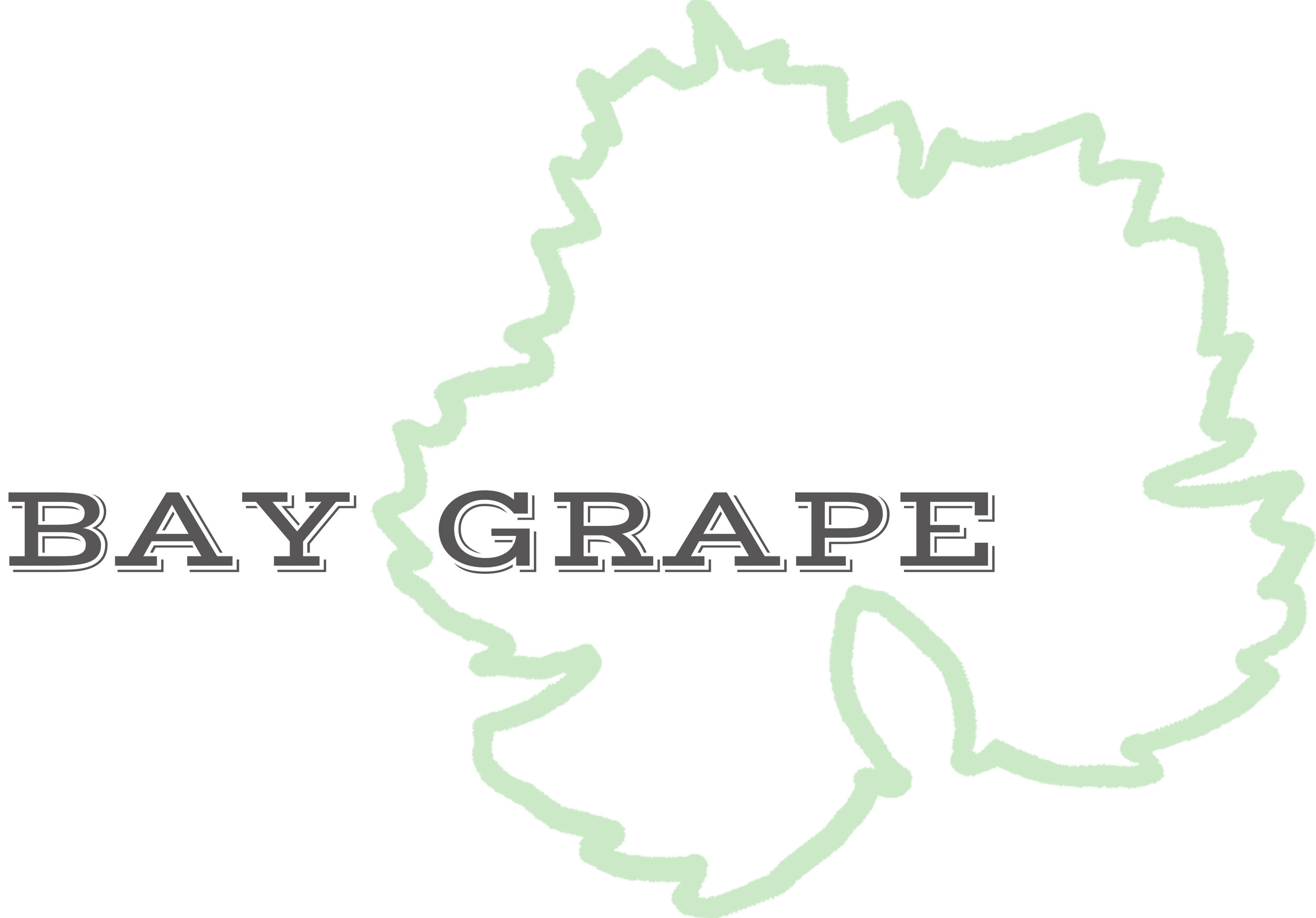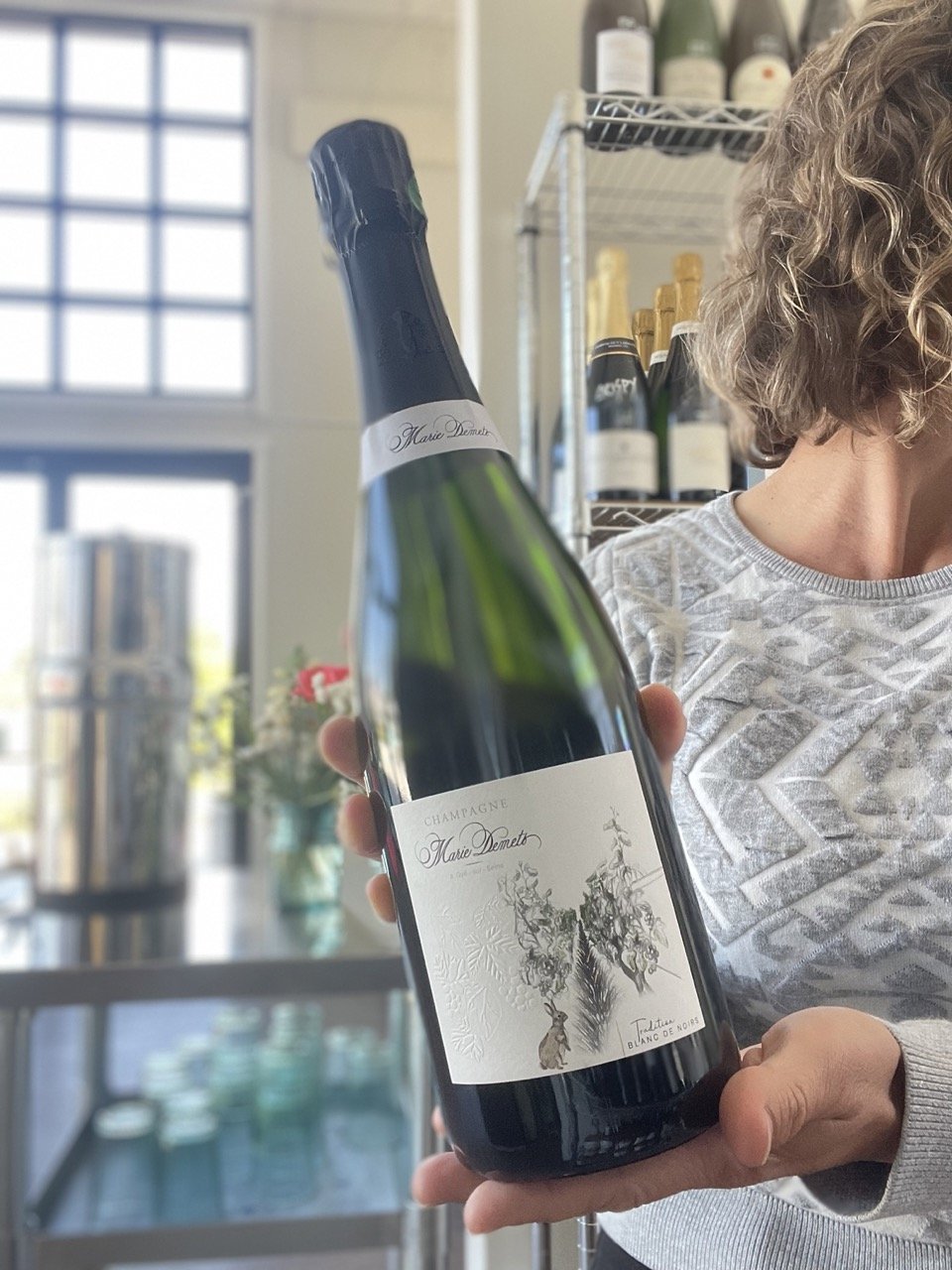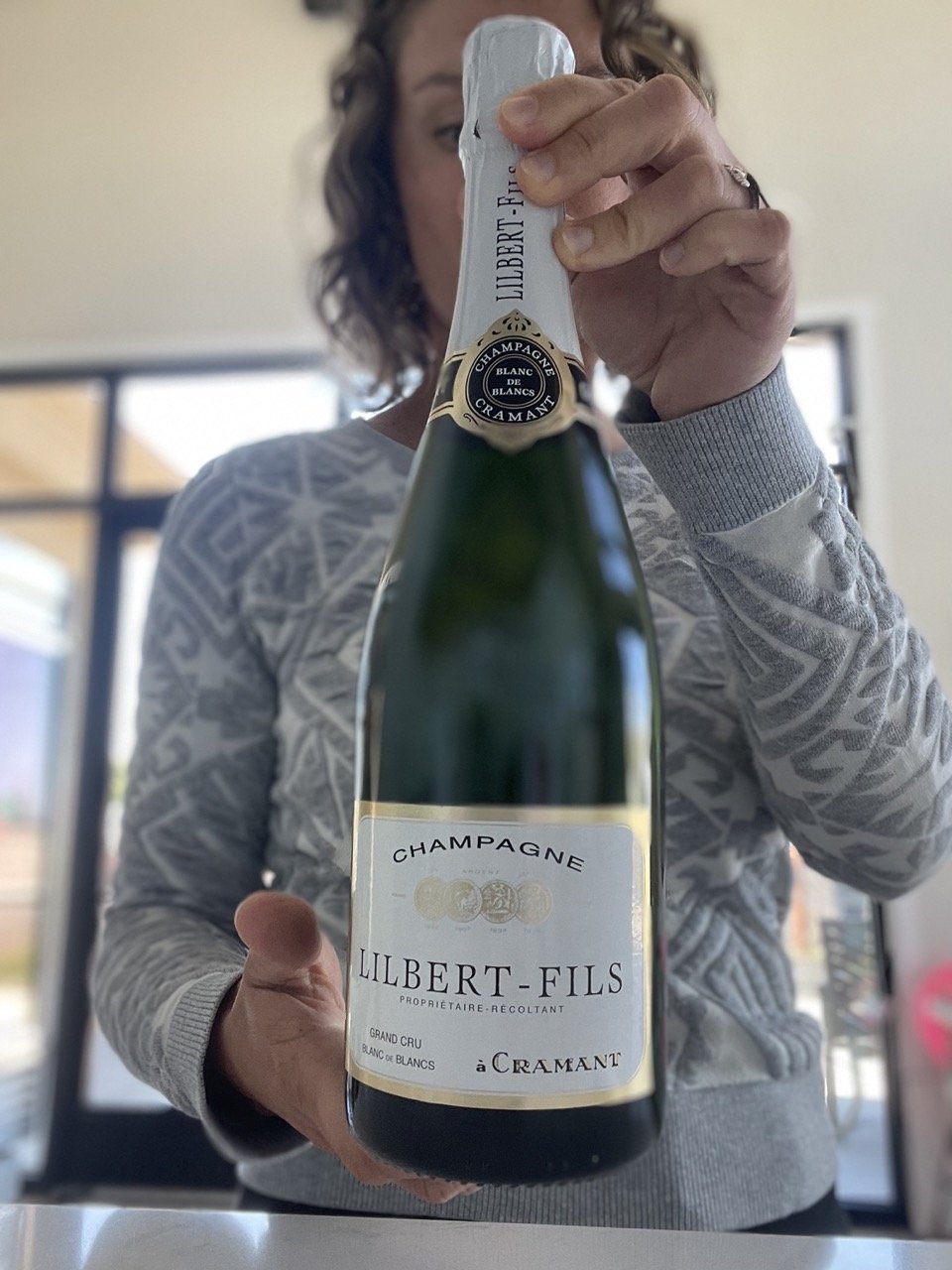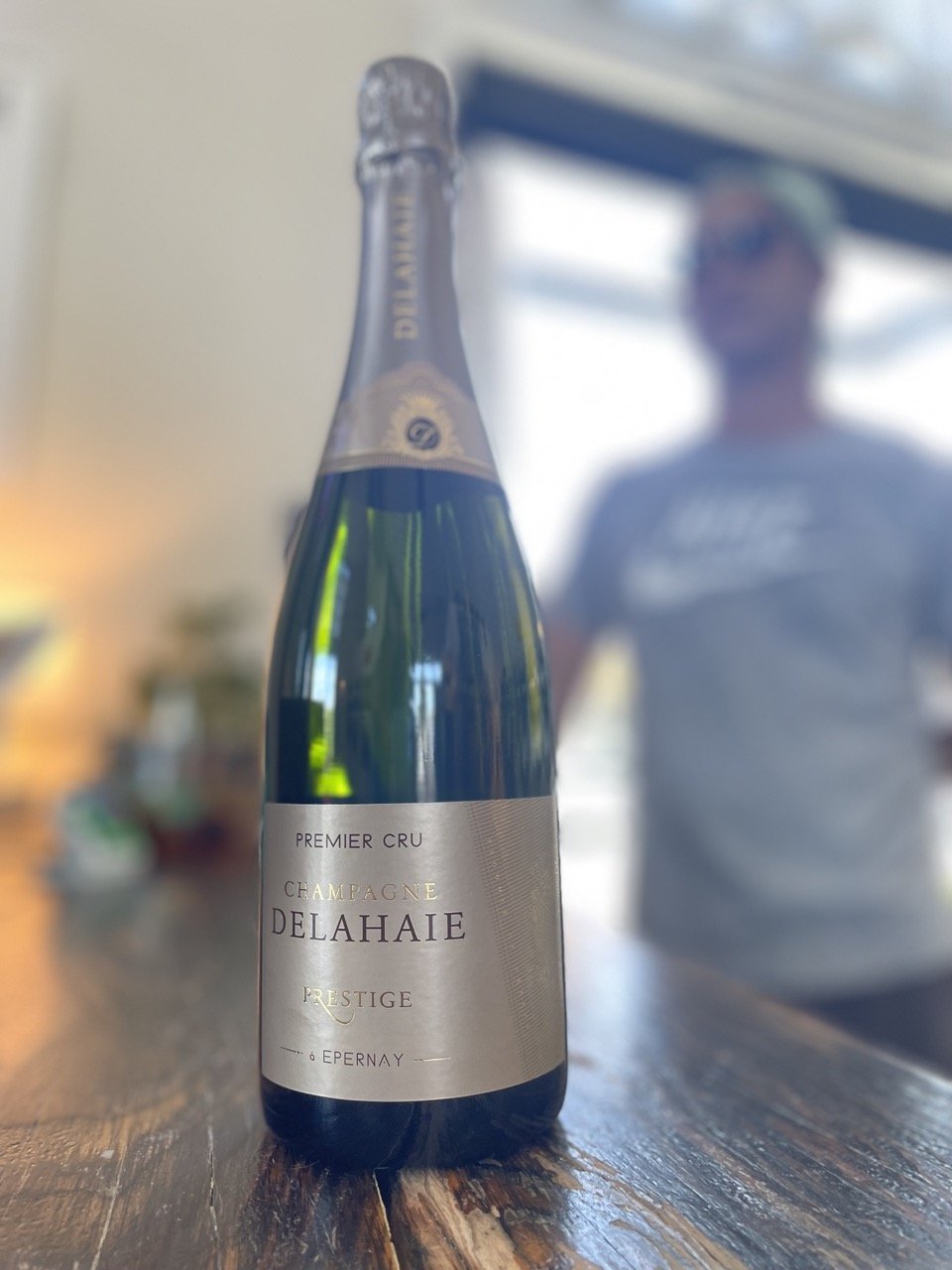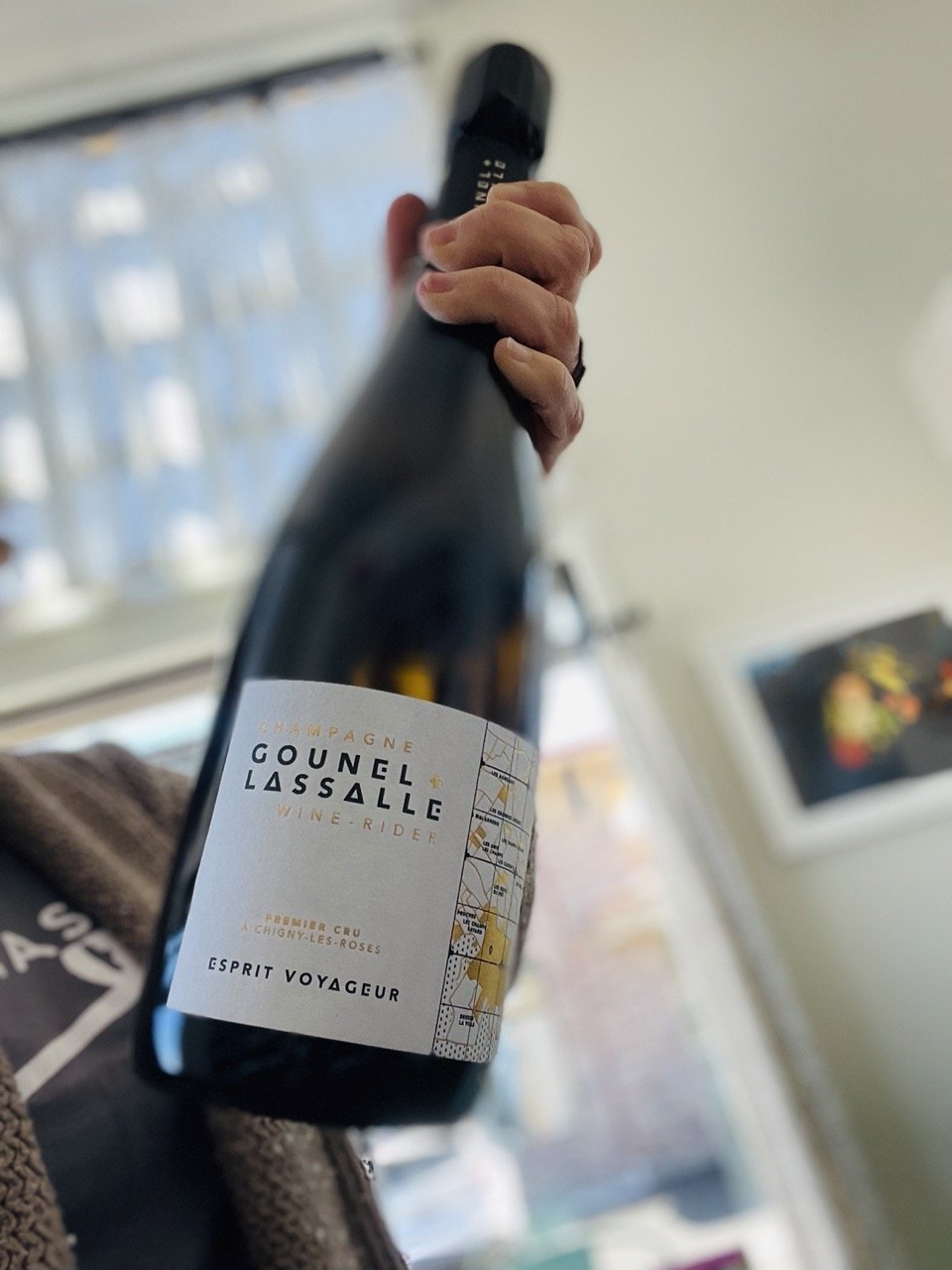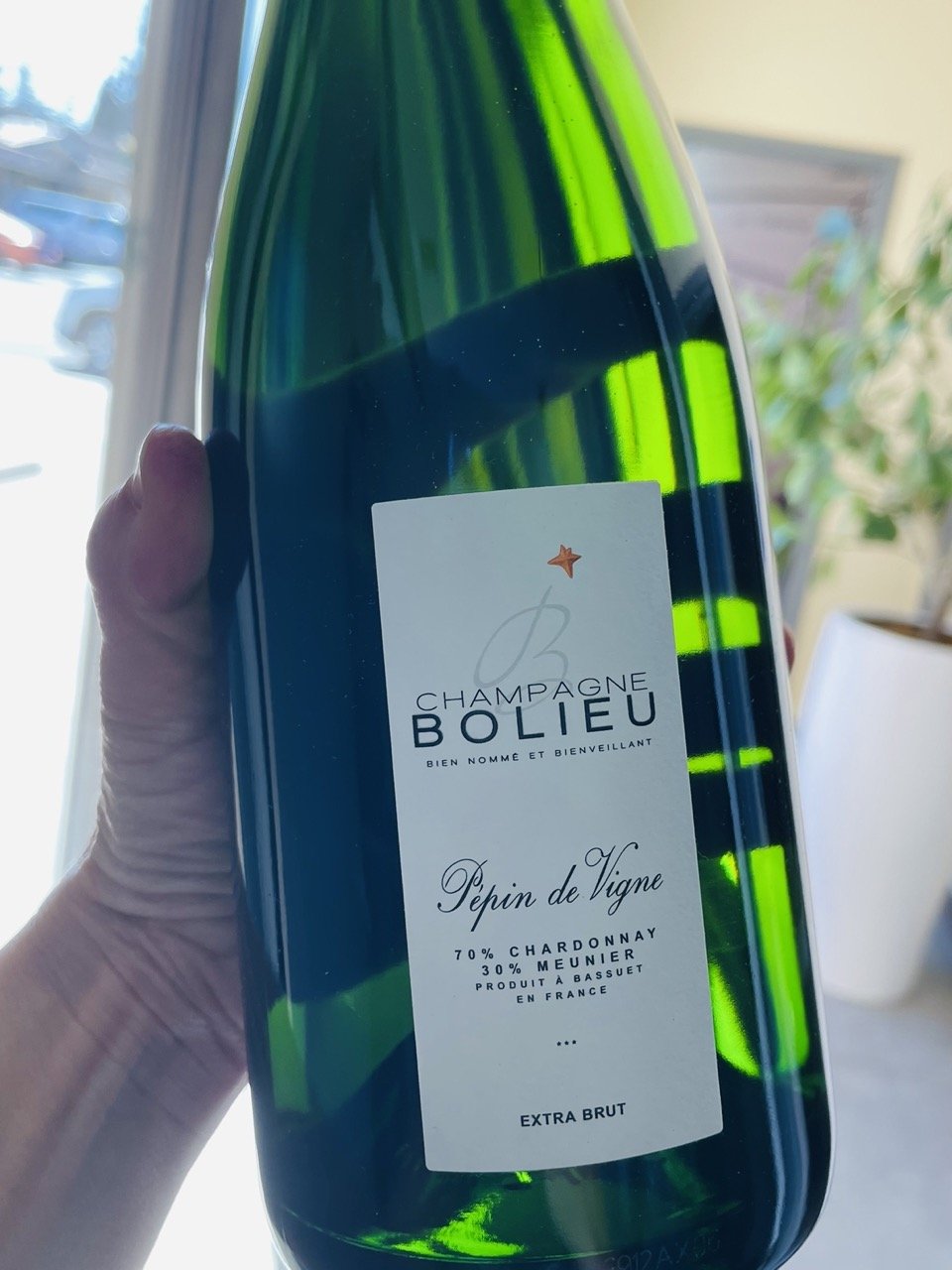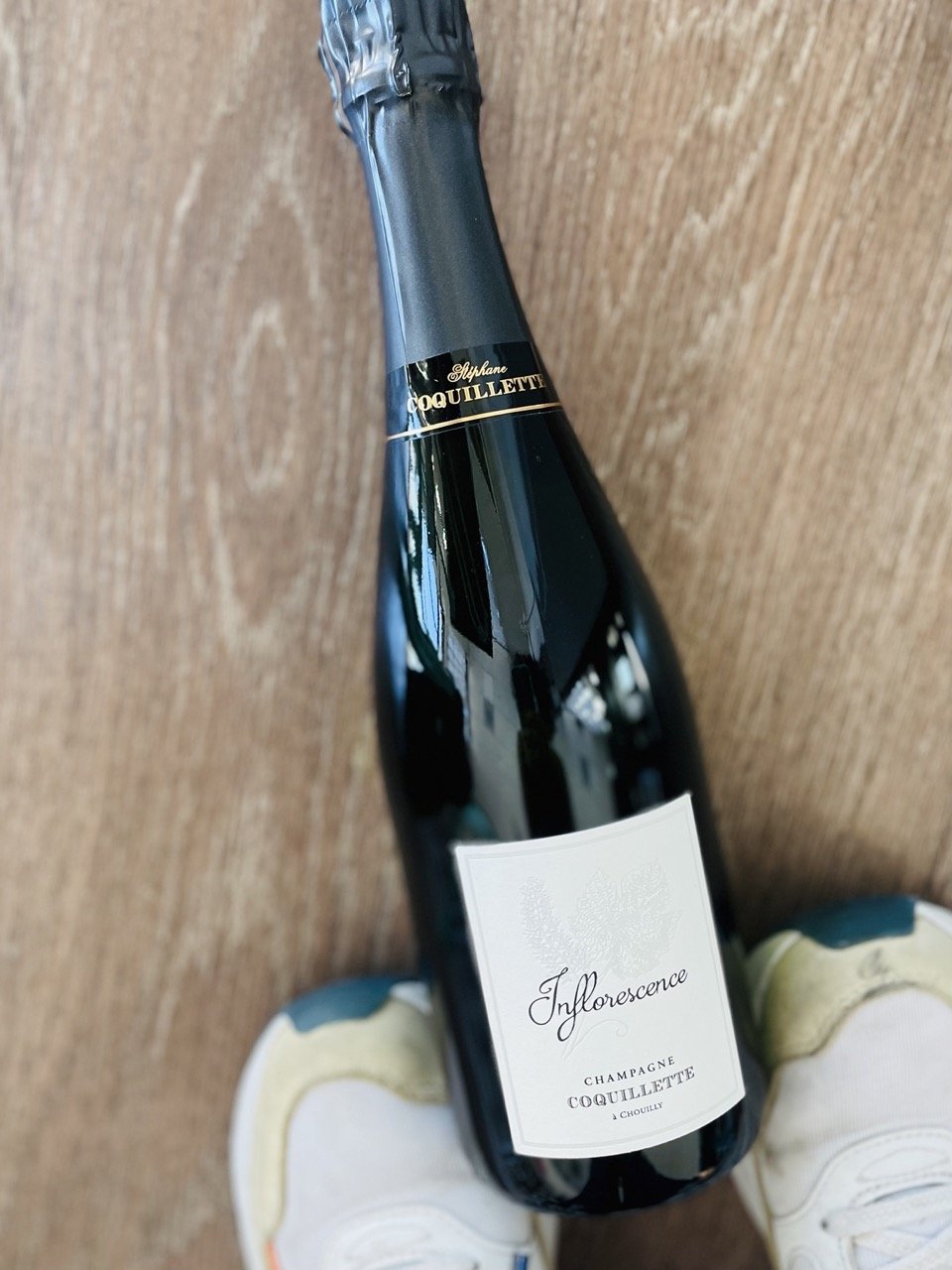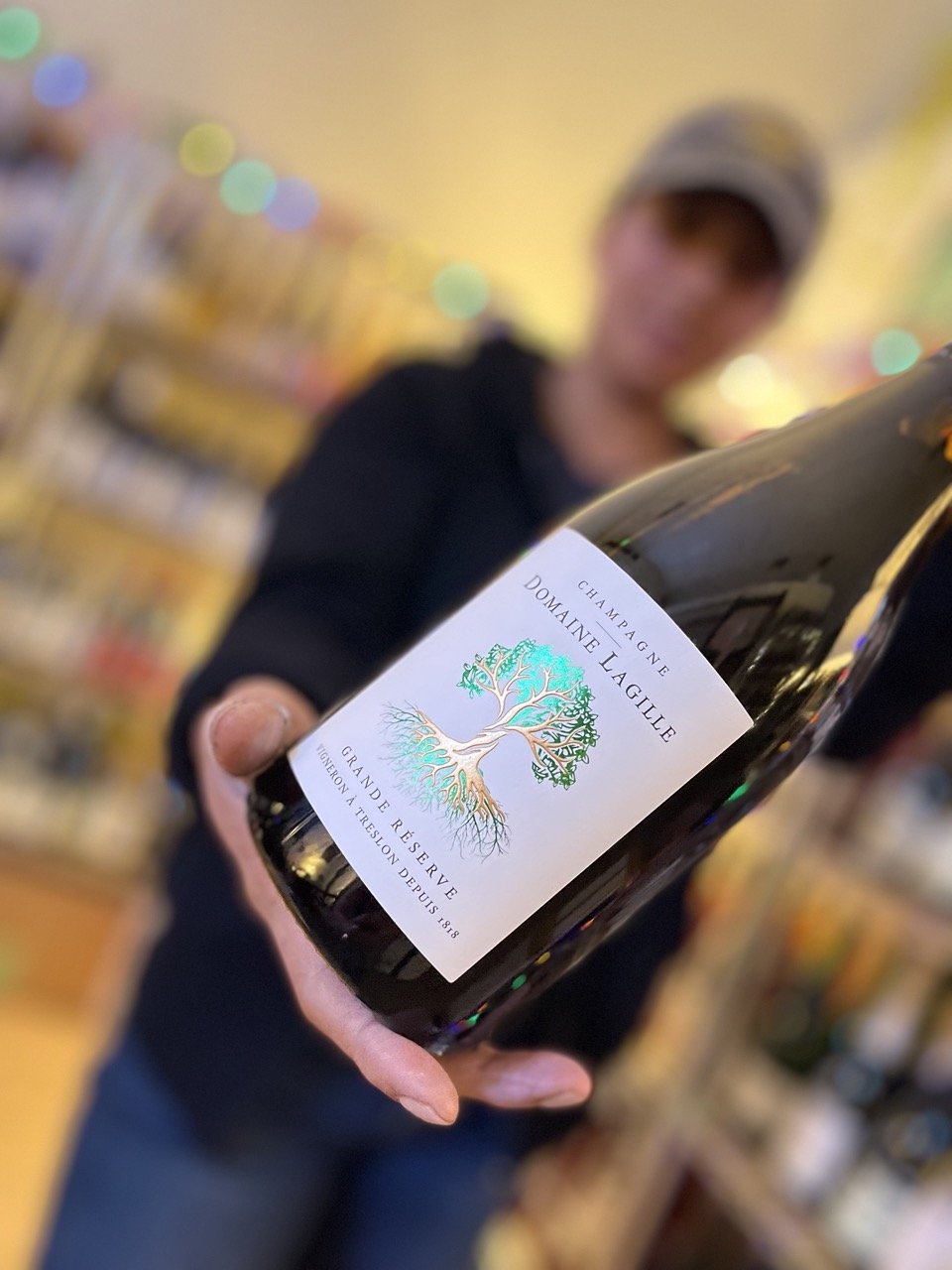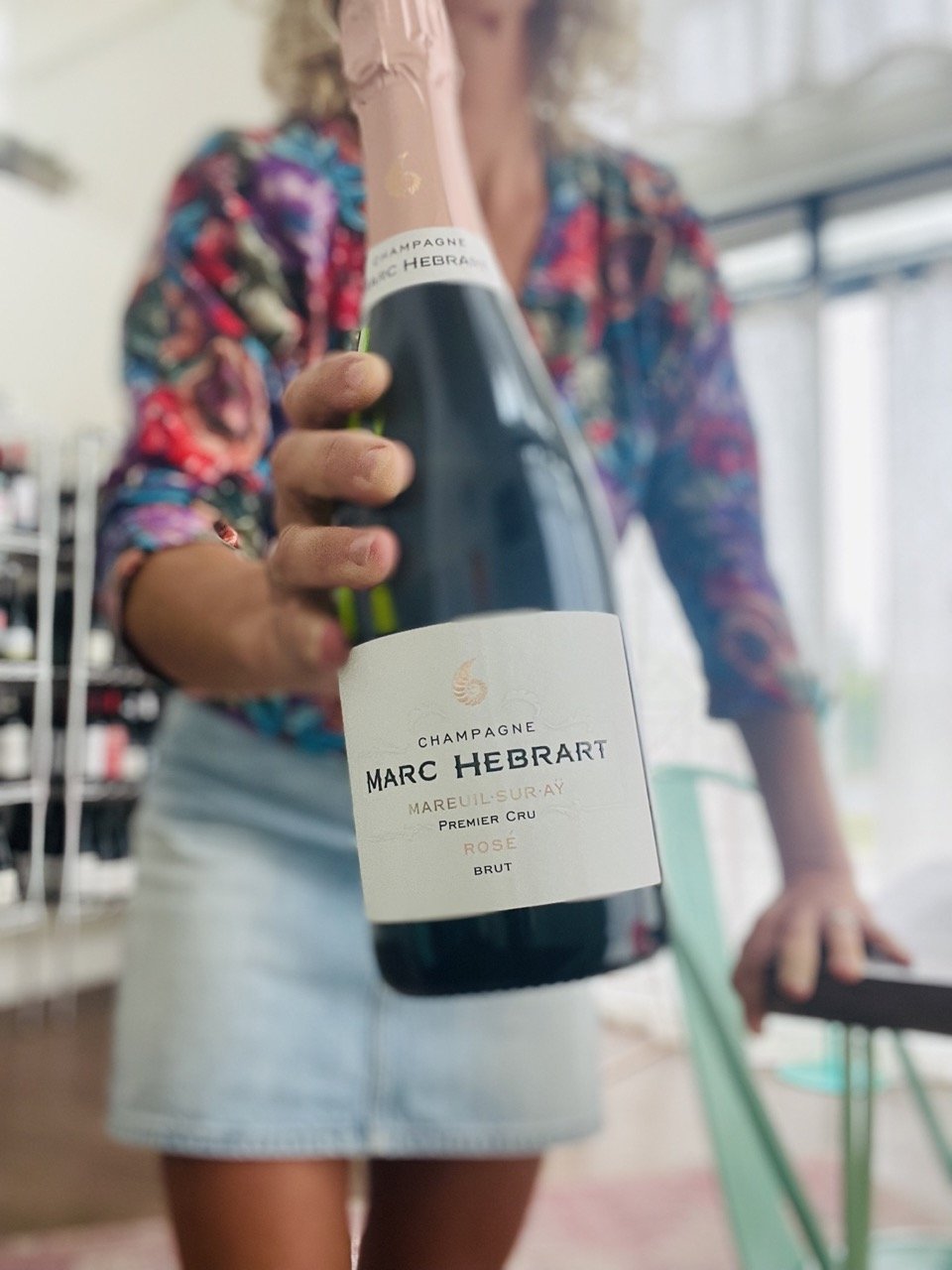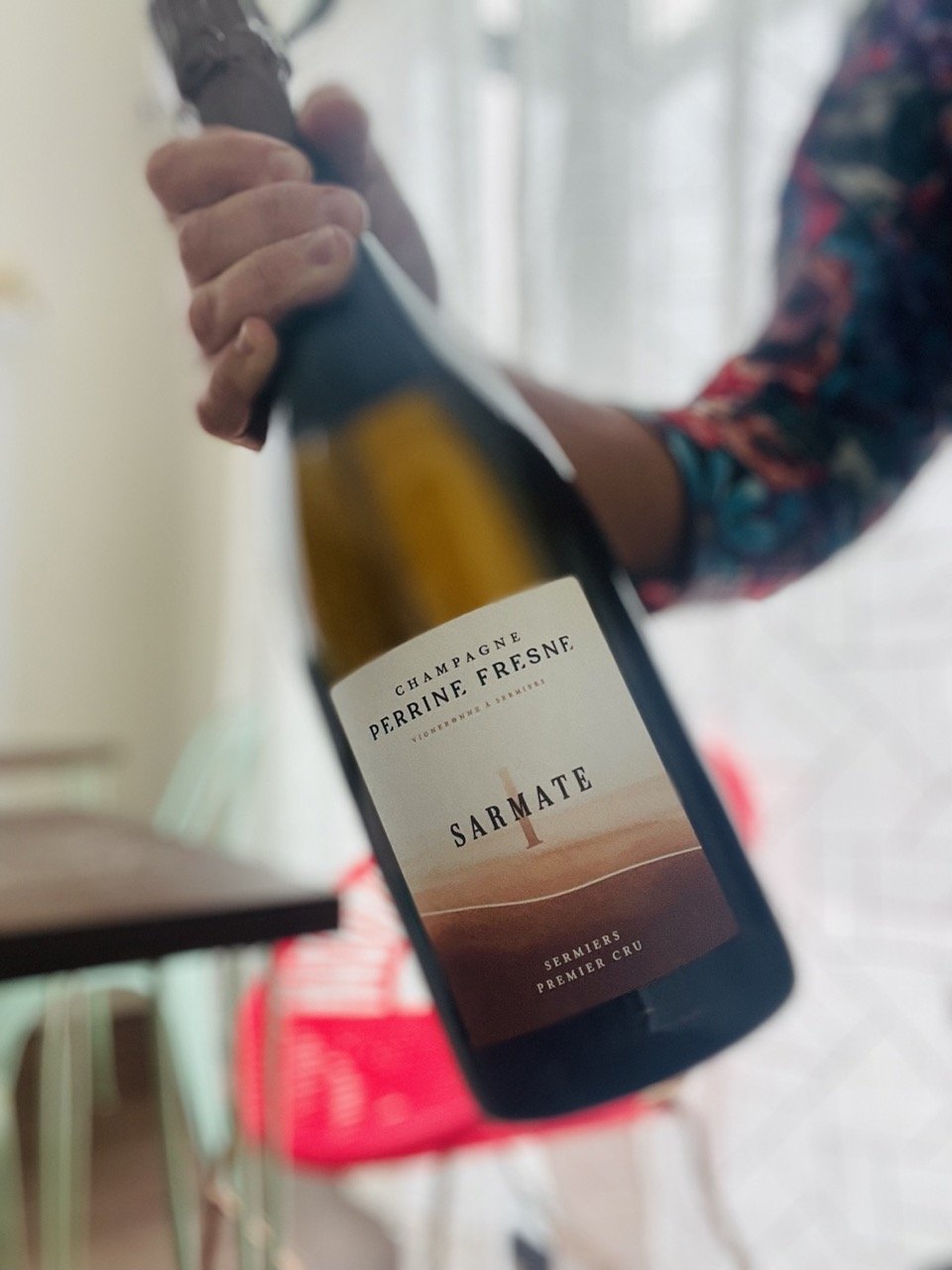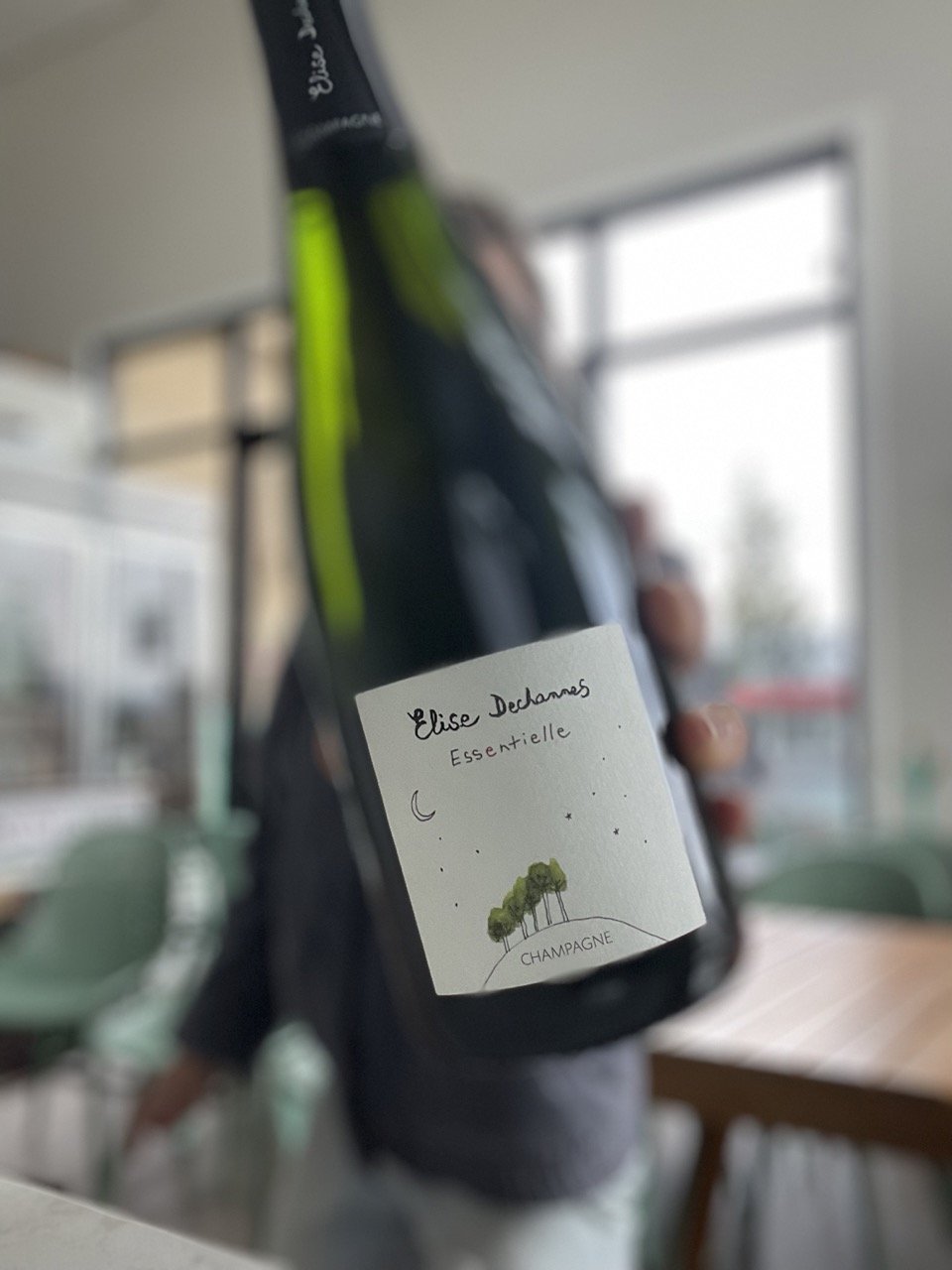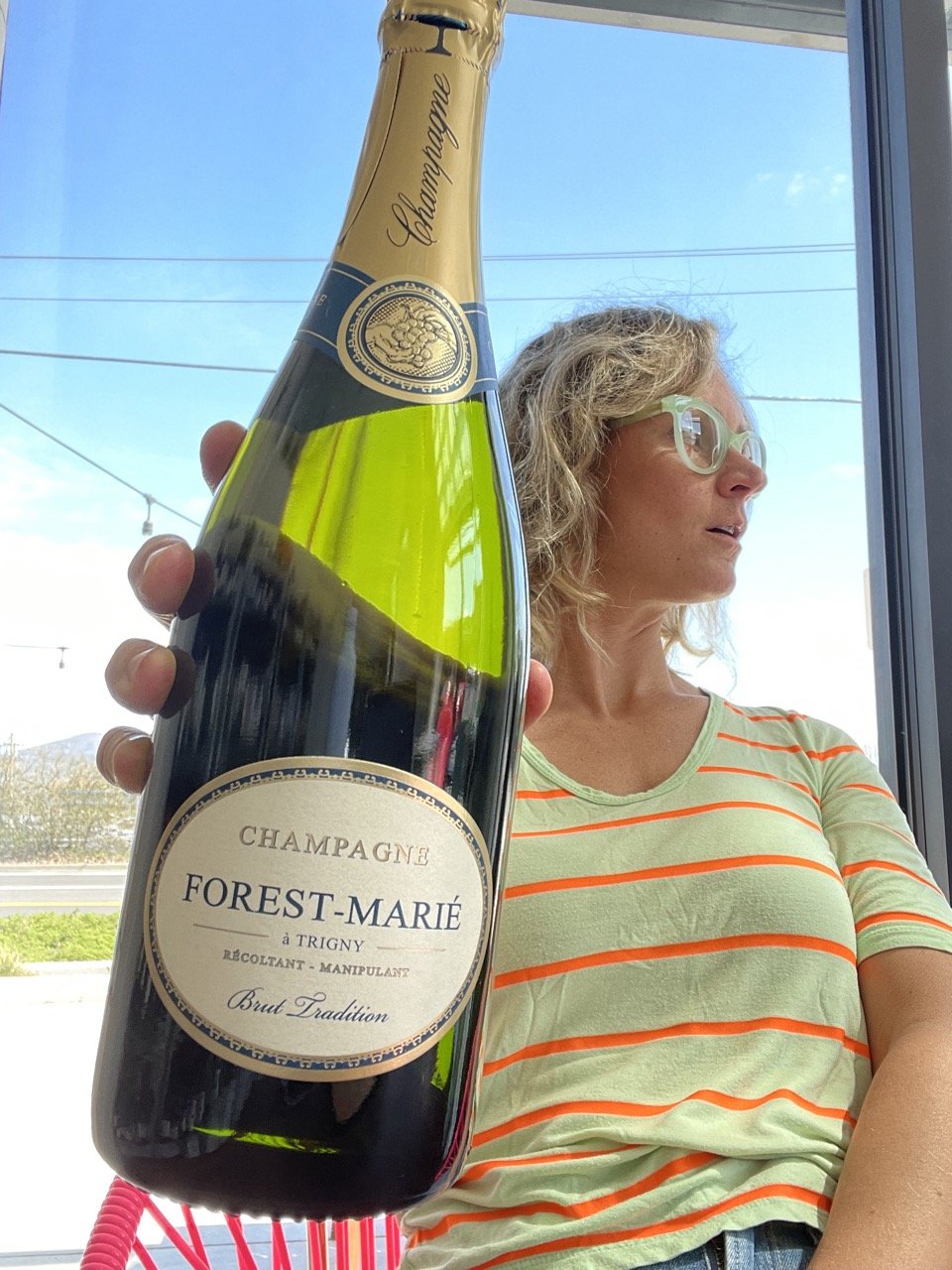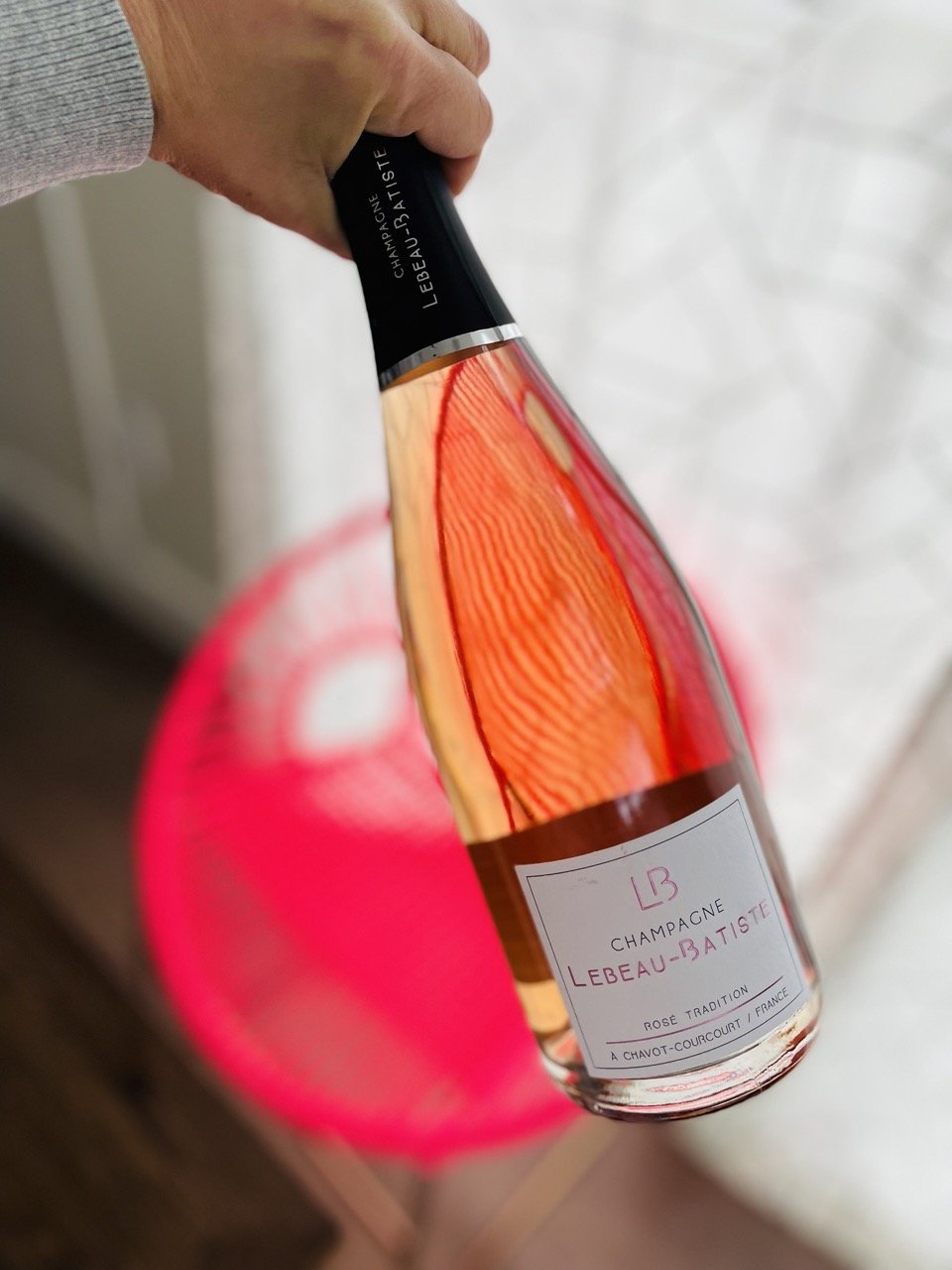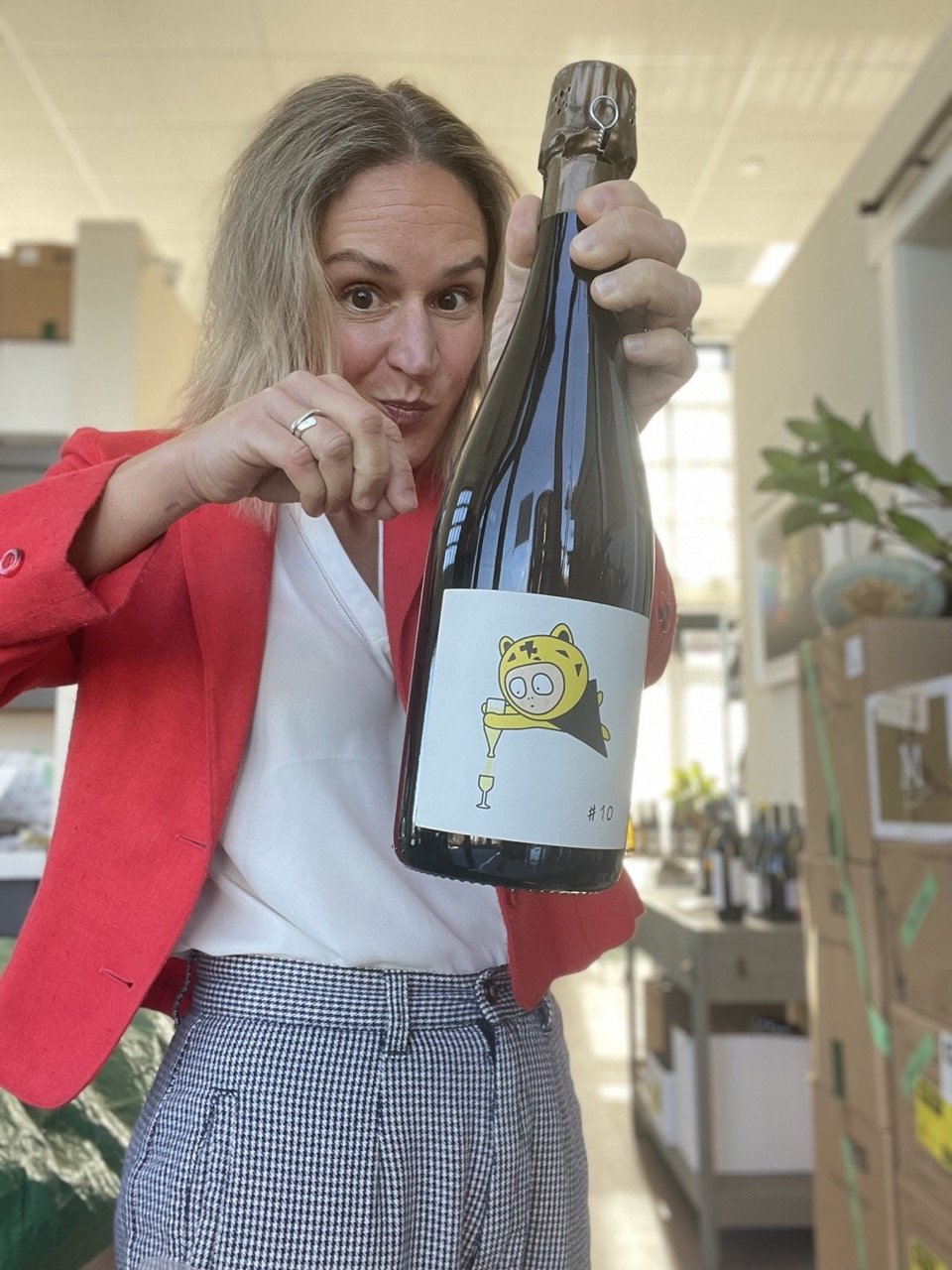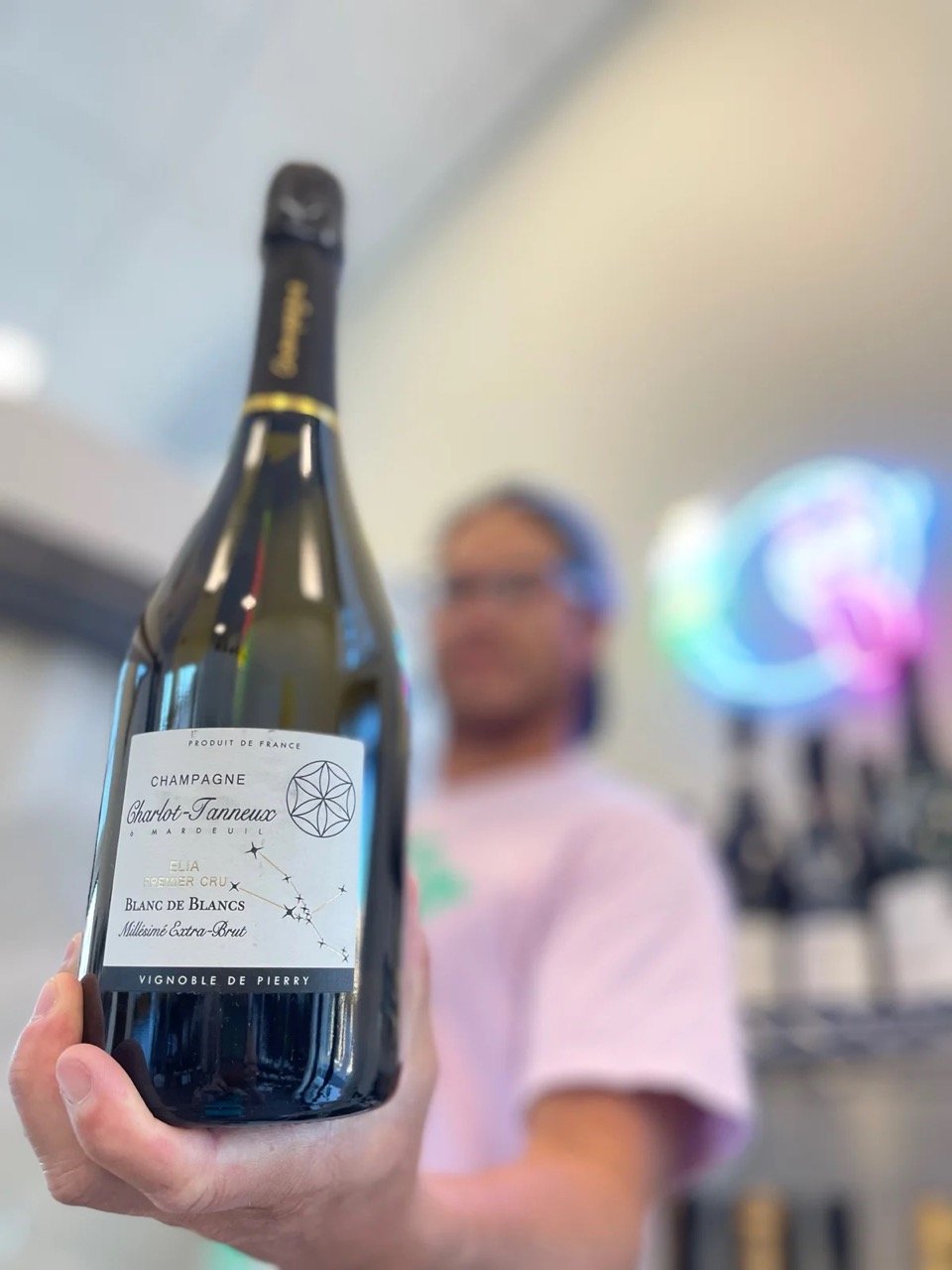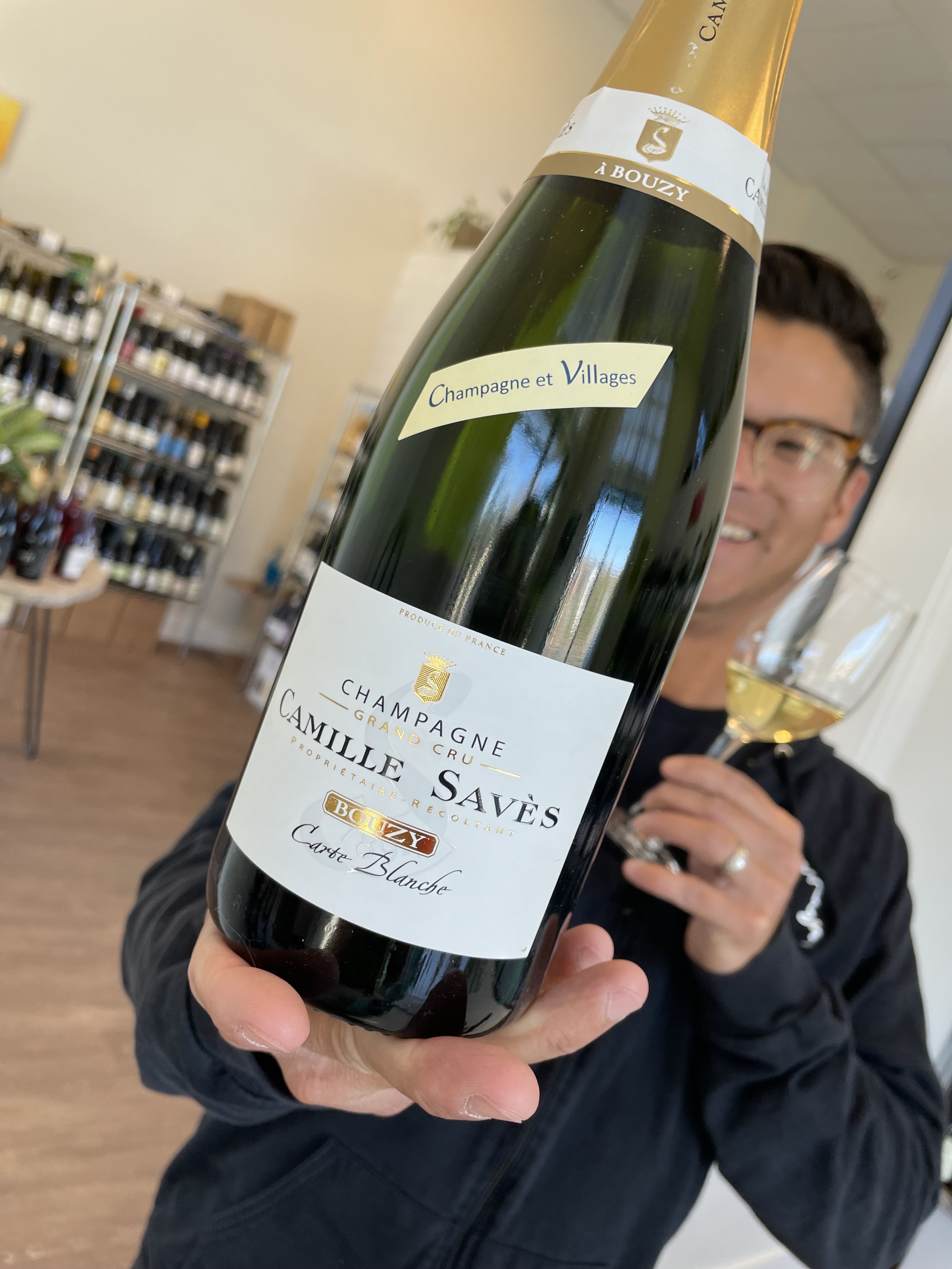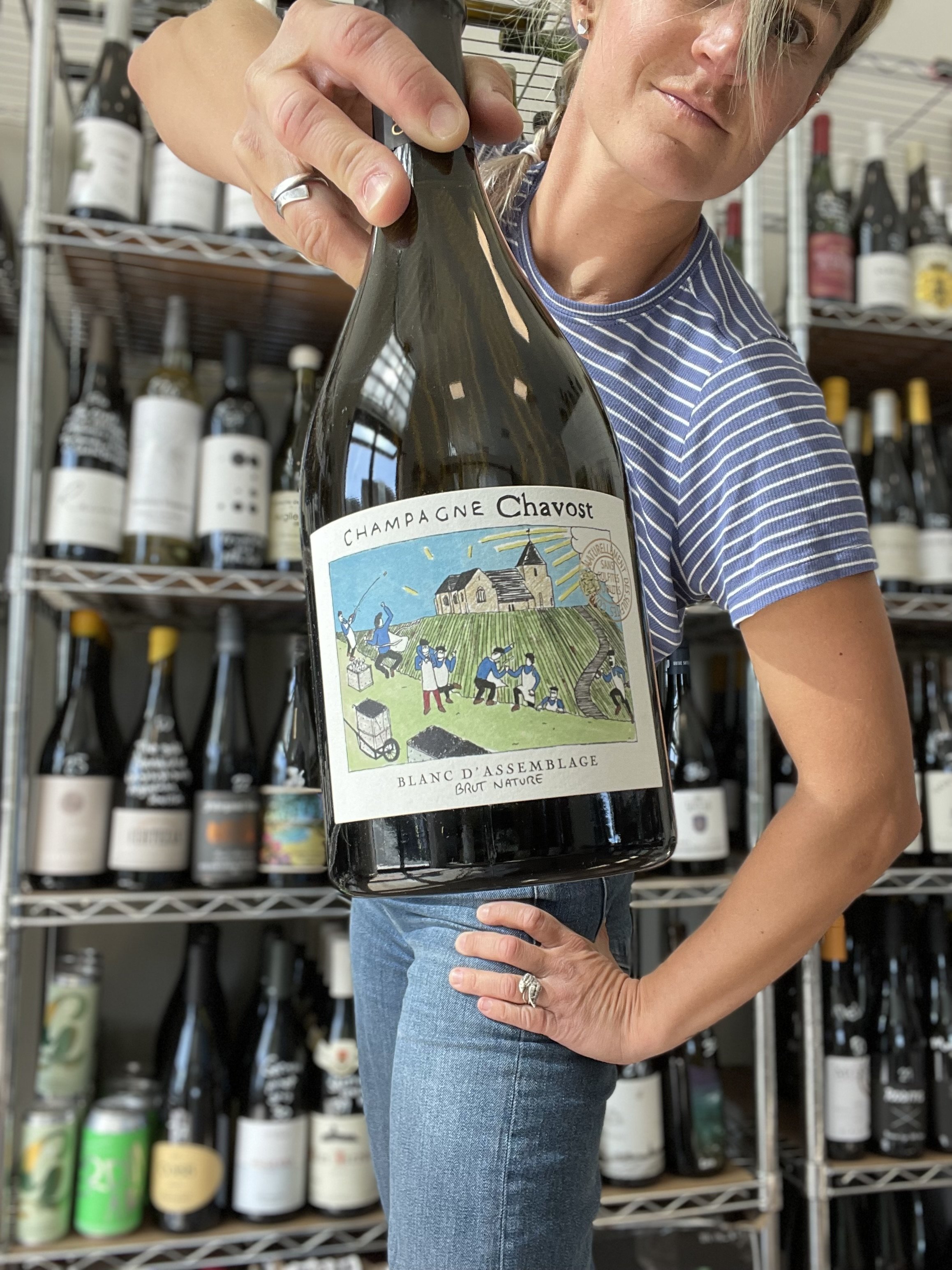champagne club cave of wonders
You’re IN! Thank you so much for being a part of our Champagne Club. We’re thrilled to introduce and share with you the true, small-production Champagnes that have most awesomely turned our heads of late.
Have fun perusing our members-only content!
Want to browse your order history and re-up on some past favorites? Log in to your member account to shop:
Base Champagne Knowledge
Villages: Champagne is a big region in northern France (it’s one of the northernmost and coldest wine regions in the world!) broken down into five (or sometimes, depending on who you ask, seven!) primary sub-regions, each of which has multiple villages that were historically classified in the Échelle des Crus by the general perceived quality of grapes grown there. Altogether there are over 300 villages whose name you may (or may not) see listed on Champagne labels.
Grapes: Chardonnay, Pinot Noir and Pinot Meunier are the main three; Arbane, Pinot Blanc, Pinot Gris and Petit Meslier are rare but also permitted.
Process: The “traditional” or Champagne method involves first fermenting grape juice into what’s known here as the “base wine” or wines. Blending of these base wines sometimes occurs, and then a secondary fermentation is initiated by adding more yeast and sugar to the wine in bottle. (A secondary fermentation happening in a tank or barrel would not qualify as true Champagne!) This secondary fermentation traps carbon dioxide in the bottle, resulting in your sparkling wine. After the second fermentation is finished, extended aging of the wine on its spent yeast cells contributes further texture, flavor and complexity. Finally, the lees (dead yeast cells) are disgorged, or popped out of the bottle, and the wine is topped up with a last splash of wine—and sometimes sugar—to round out the final product. Whew!
Glossary
Blanc de Blancs: Literally “white from whites” or a white wine made entirely from Chardonnay.
Blanc de Noirs: Literally “white from blacks” or a white wine made by pressing the clear juice from the red (black) grapes Pinot Noir and/or Pinot Meunier and immediately separating off the skins so no skin-contact and bleeding of red color into white wine occurs.
Cépage: The specific blend of grapes used in the Champagne (e.g. 70% Pinot Noir; 30% Chardonnay).
Disgorgement: The removal of the spent yeast cells from the bottle after extended aging.
Dosage: The amount of sugar, measured in grams per liter, added to the final Champagne to balance its naturally very high acidity. 0-3g/l = Brut Nature (aka Non-Dosé or Brut Zéro); 0-6g/l qualifies as Extra Brut; Brut is defined as 0-12g/l. There are almost no Champagnes currently released today that are sweeter than “Brut,” but the next levels of sweetness are Extra Dry, then Sec, Demi-Sec, and finally Doux as the sweetest.
Sur lie: On the lees. The lees are the spent or dead yeast cells leftover after fermentation. Champagnes traditionally age sur lie for a minimum of 12 months for non-vintage Champagne and 36 months for vintage Champagne.
sPRING 2025
lAHERTE fRERES
blanc de blanc
Brut Nature
Producer: The Laherte family has a long history in the area. Founded in 1889 by Jean-Baptiste Laherte, the estate started with vines mostly in Chavot. Today, under Aurélien Laherte, who took over in 2005, it has become a leading estate in the region. They produce small batches of single-vineyard, single-vintage wines (about 3,000 bottles each) from unique biodynamic farms. The wines are made in used Burgundy barrels, without malolactic fermentation, and are bottled without fining or filtration. Little or no sugar is added to keep the true character of the land.
Village: Many of Laherte’s champagnes reflect the unique character of Coteaux Sud d’Epernay, located south of Epernay between Côte des Blancs and Vallée de la Marne. The area is diverse, with Laherte identifying 15 different terroirs in Chavot, which he vinifies separately to maintain their distinct flavors.
Vintage: NV (50% Reserve wine)
Cépage: 100% Chardonnay
Dosage: 0g/L
Disgorged: May 2024
Pair it with: Aged Gouda or other hard cheeses, dungeness crab.
R.H. Coutier
A Ambonnay
Brut Tradition
Producer: The Coutier family sustainably farms nine hectares, producing only 2,000 cases of Champagne and selling most of their grapes to a local cooperative. This reflects true grower Champagne. Grapes are hand-harvested, pressed with stems to filter and drain naturally, ensuring clear juice from the Pinot Noir. To maintain freshness and acidity, about half of the wines undergo malolactic fermentation, depending on the vintage. Most wines do not use barrel fermentation or aging, except for “Cuvée Henri III,” where half ages in barrels for controlled micro-oxygenation. All bottles are hand-riddled, and low dosages highlight the natural fruit and terroir characteristics. R. H. Coutier is one of the top domaines in Ambonnay and offers a great introduction to grand cru Champagne.
Village: The grand cru village of Ambonnay produces some of the greatest Champagnes in the heart of the region’s prestigious Montagne de Reims. The Coutier family has been in the village since 1619, with René Coutier being the fourth generation to run the estate. While Ambonnay is famous for its Pinot Noir, René's father was the first to plant Chardonnay there in 1946. This unique choice shapes the Coutier style, blending the richness of Ambonnay's Pinot Noir (70%) with the fresh crispness of Chardonnay (30%). The vineyards benefit from a warm microclimate due to their south-east facing exposure and have a soil rich in clay, enhancing the wines' depth.
Vintage: NV (40% Reserve wine)
Cépage: 70% Pinot Noir, 30% Chardonnay
Dosage: 6g/L
Disgorged: Sept 2024
Pair it with: Creamy or stinky cheeses, fresh fruit, salmon, your mouth
Make it stand out
Producer: Mignon has a unique farming style which uses natural techniques like biodynamics, plant therapy, homeopathy, and geobiology. He views nature as a rubik's cube, always changing and full of challenges. Mignon looks for subtle issues in his work and enjoys finding creative solutions. With the mindset of an engineer and the passion of a fifth-generation farmer, he has developed special tractor blades to perfectly work the soil around his vines and a homeopathy machine that mixes copper, valerian root, and garlic to cope with nature's challenges.
Village: Mignon comes from a long line of farmers in the hamlet of Le-Mesnil-le-Huttier, 13 miles west of Epernay. His 6.3 hectares of vines were planted by his great-grandparents and are spread among thirty parcels between the villages of Le Breuil and Festigny in the Vallee de la Marne. This area south of the Marne River and along the Flagot tributary is known for its high percentage of Pinot Meunier, which is particularly well suited to the deep clay and chalky Tuffeaux soils dominating the terrain.
Vintage: NV (equal parts current and each two previous vintages)
Cépage: 100% Pinot Meunier
Dosage: 0g/L
Disgorged: July 2023
Pair it with: Creamy or stinky cheeses, fresh fruit, salmon, your mouth
Winter 2024/25
Matthieu Godmé-Guillaume V.V.V 1er Cru Extra Brut NV
Producer: The young and [bio]dynamic Matthieu Godmé-Guillaume is only a couple of years into his own label, which is likely why you’ve not (yet!) heard of him. YOU HEARD IT HERE FIRST, as we anticipate his to be a swiftly ascending star course. His great grandparents started the family business with purchases of plots of land in the Montagne de Reims; just a few years ago Matthieu bought up some of that land and the cellars from his father so he could do his own thing, focused on biodynamic farming, improving soil health, and fermenting in a combination of steel, cement and oak—often choosing the exact trees for his barrels!—to carefully craft the texture and trajectory he feels each wine is owed.
Village: The V.V.V in the wine name stands for the three villages of Verzenay, Verzy, and Villers-Marmery, where Matthieu Godmé-Guillaume owns vineyards, and between which lies his cave. Verzenay and Verzy are Grand Crus, while Villers-Marmery is a Premier Cru, so this is hallowed ground in the northeastern corner of the Grande Montagne de Reims sub-region.
Vintage: NV (based on 2021 vintage with 48% reserve wines)
Cépage: 74% Chardonnay, 26% Pinot Noir
Dosage: 4g/l (Extra Brut)
Disgorged: October 2023; note the wines usually only spend around 16 months sur lie to bolster freshness rather than a toasty, autolytic character
Pair it with: seafood towers; bánh xèo (crispy Vietnamese crepes); snowshoeing
Guy Larmandier 1er cru Brut Zero vertus NV
Producer: Quietly, without fuss or performative fanfare, the wines of Guy Larmandier have amassed an ardent following, even as they’re often overlooked by name-brand buyers who gloss over them for the better-known wines of his brother, Larmandier-Bernier. Still, both estates are based in Vertus, both are carefully and thoughtfully farmed, and both emphasize the ample stoniness of that village. Guy founded his family estate from his share of the family’s vines, and his domaine is now run by his wife, Colette, and their children François and Marie-Helene. The house style is chiseled, limestone-and-chalk-forward, intense yet also aromatic; the Brut Zero is surprisingly dense for a zero dosage cuvée, thanks to lengthy lees aging.
Village: The Premier Cru village of Vertus is at the southern end of the Côte des Blancs sub-region of Champagne. It faces east, full of unmitigated chalky slopes that play up its Queen Bee Chardonnay status.
Vintage: NV
Cépage: 90% Chardonnay, 10% Pinot Noir
Dosage: 0g/l (non-dosé/Brut Zero)
Disgorged: July 24, 2024—the Guy Larmandier wines imported into the U.S. always spend a minimum of 36 months sur lie and are always disgorged to order immediately prior to their shipping over.
Pair it with: breakfast strata; latkes; sibling rivalry
Autumn 2024
LAHERTE FRERES LES VIGNES D’AUTREFOIS EXTRA BRUT 2019
Producer: The Laherte family is like grower Champagne royalty. Founded formally as a producer in the village of Chavot-Courcourt in 1889, they’ve been not only growing but also making their own wines for most of that time and have always been amongst the most progressive thought-leaders of their region. When Aurélian took over in 2002, he modernized the winemaking equipment while going decidedly the opposite direction in terms of everything else: less intervention and manipulation, a full elimination of chemicals and pesticides, eventually organic certification and biodynamic farming. He also spearheaded the “Terres et Vins” mini think-tank of the most progressive local producers (i.e. Benoit Lahaye, Agrapart, Marie Courtin and more) with the goal of pushing toward more regenerative viticulture, more terroir expression in the wines, and more vinous overall styles of Champagne.
Village: The fruit for the Autrefois comes 75-year-old massale selection Pinot Meunier vines in the villages of Chavot-Courcourt and Mancy. Chavot-Courcourt seems to be Champagne’s most “in crowd,” of-the-moment village (see earlier Champagne club features from fellow rising star villagers Lebeau-Batiste and Chavost). Nestled against the western border of the Côte des Blancs, five minutes south of Epernay and a few minutes northwest of Grand Cru villages Cuis and Cramant, this village is a treasure trove of old vines and ancient limestone vineyards.
Vintage: 2019 was a decidedly challenging year (mildew then sunburn then HAIL!) that, for growers like Laherte who sorted fastidiously, turned out shockingly wonderful wines. The ‘19s are ripe and exuberant with snappy aromatics, surprising acidity and long, juicy length. The 2019 Les Vignes d’Autrefois was picked entirely by hand and fermented in old Burgundy barrels without malolactic fermentation.
Cépage: 100% Pinot Meunier
Dosage: 2-4 g/l (Extra Brut)
Disgorged: unknown
Pair it with: oven-roasted tomato and herbed goat cheese galette; chana masala; setting five-year goals
AUBRY BRUT ROSÉ CHAMPAGNE NV
Producer: Peter Liem (widely considered the most knowledgeable Champagne expert in the world, honestly) calls twin brothers Pierre and Philippe Aubry’s cuvées “quirky, original Champagnes.” While we’re not sure “quirky” is as euphemistic a word choice as we’d opt for, we do concede that the house’s frequent focus on Champagne’s “other” varieties (Arbanne, Petit Meslier, Fromenteau and Pinot Blanc) makes them unique. That’s one reason we love them and especially their Brut Rosé, which boasts all seven permitted Champagne varieties and seems to rock a little extra fun and flamboyance as a result.
Village: Jouy-Lès-Reims is a Premier Cru village in the northwestern portion of the broader Montagne de Reims sub-region (an area referred to as Petite Montagne de Reims) and is known for its preponderance of fossil-encrusted limestone, thought to contribute a certain lifted, saline quality to the wines.
Vintage: NV
Cépage: 40% Chardonnay, 35% Pinot Noir, 20% Meunier, 5% Arbanne, Petit Meslier, Fromenteau and Pinot Blanc
Dosage: Brut (0-12 g/l)
Disgorged: November 2022 and April 2023
Pair it with: bánh mi; Ethiopian pumpkin stew; costume parties
Summer 2024
Marie Demets Tradition Blanc de Noirs Extra Brut Gyé-sur-Seine NV
Producer: Pierre Demets, his wife, Mathilde, and their three young children run his grandfather’s estate—named for his mother—and he’s carefully tip-toeing towards modernity while respecting the traditions of the two generations that laid the groundwork for him. While Grandpa was focused on establishing the family’s vineyards; Dad focused on classic winemaking; today, Pierre and Mathilde are bringing the estate up to speed with a focus on sustainability so that, hopefully, their three children have a vineyard and a planet to look forward to. Their farming is homeopathic, using tinctures from plants to fertilize and pest-control; they sow ground-covers and shallow-till gently. They vinify each of their plots separately, ultimately crafting final cépages focused on coaxing out intense aromatics and rich concentration.
Village: Gyé-sur-Seine, originally just named Gyé, lies on the River Seine in the Côte des Bar (a.k.a. the Aube, the southernmost sub-region of Champagne). The Aube is prized for its Kimmeridgian limestone soils and warmer climate, making these wines decidedly vinous and muscular.
Vintage: NV (42% 2021 vintage base)
Cépage: 100% Pinot Noir
Dosage: 4 g/l (Extra Brut)
Disgorged: unknown
Pair it with: croque madames or medianoches; spinach-artichoke dip; sidewalk chalk
Lilbert-Fils Grand Cru Blanc de Blancs extra brut Cramant NV
Producer: Bertrand Lilbert took the reigns from his father, George, in 2005, and under his guidance the family’s wines’ reputations have skyrocketed, due in part to Peter Liem (the Champagne guru of gurus) noting in 2014, “The only problem with these wines is finding them, as the tiny production is eagerly snapped up upon release by a near-cult following of clientele around the world.” If Peter Liem tells people there’s a cult following, that cult membership is going to double in size while everyone doubles down on the snapping. Why the hype? Because these represent the epitome of the grower Champagne movement: Tiny quantity (8.6 acres of vines and only 2,200 cases annually in total!) yet pristine quality emerging from100% Grand Cru chalk soils.
Village: The NV Blanc de Blancs comes from all three villages where Bertrand farms his minuscule parcels of vines: 60% Cramant, 30% Chouilly, 10% Oiry. We’re in the heart of the Côte des Blancs, where the soft tuffeau and chalk lend Chardonnays of both generosity and elegance.
Vintage: NV
Cépage: 100% Chardonnay, all from the first pressing
Dosage: 3 g/l (Extra Brut)
Disgorged: Spring 2022
Pair it with: new potatoes and peas in béchamel; salt-baked branzino; company you don’t get to see often enough
Delahaie Cuvée Brut Prestige Premier Cru NV
Producer: This is a bit of a new kid on the Champagne block. The estate was started in 1959 by Monsieur Delahaie who came to Epernay (that most famous village based around the prestigious Avenue de Champagne, where everyone who’s anyone in Champagne has a grand maison) to do business. As one does “when in Rome,” he made a small bit of wine with the help of an oenologist, selling it only to private clientele. By 1988, with no direct descendant, he transferred his small estate to his nephew, Jacques Brochet, who ramped up the quality in terms of fruit-sourcing and production and has quietly built up a budding reputation as a top “micro” négociant crafting rich, exotically fruited and tangy Champagnes.
Village: The estate is based in Epernay, but the fruit is sourced from exclusively Grand or Premier Cru vineyards throughout the Champagne region.
Vintage: NV
Cépage: 40% Chardonnay, 60% Pinot Noir
Dosage: 10 g/l (Brut)
Disgorged: unknown
Pair it with: quiche Lorraine; French toast with citrus curd; live music
Spring 2024
Gounel Lassalle Esprit Voyageur 1er cru Brut Nature Champagne NV
Producer: Arnaud Gounel runs his family’s newly-imported-to-the-US Champagne house alongside his wife Sophie. Arnaud took over as the fourth generation in line in 2002, when he decided it was high time their small-but-mighty estate “flew the coop”—and by coop, we really mean village cooperative, which the family had been a part of for the better part of a century. Recognizing their top-quality, organically farmed fruit and his commitment to artisanal, in-house production, he steadfastly worked towards becoming a récoltant-manipulant, achieving his goal with the 2018 vintage. Arnaud always barrel-ages his base wines, ardently believing that the micro-oxidation process in oak lends crucial depth, aromatics and structure to his wines, and he always foregoes any dosage.
Village: The Gounel family is in the Montagne de Reims’ sub-region’s Chigny-les-Roses Premier Cru village. It sits halfway between the two major towns of Epernay and Reims, directly southeast of the Rilly-la-Montagne village, with mostly north-facing slopes. While most of Chigny-les-Roses is planted to Pinot Meunier, they also work a special parcel called Les Ruelles, which is all Chardonnay, and has been that way since at least 1870, when it belonged to Arnaud’s great grandparents. Arnaud calls this parcel “the heart of the family maison.”
Vintage: NV
Cépage: 58% Pinot Meunier, 25% Pinot Noir, 17% Chardonnay; 1/3 of the cuvée is reserve wine
Dosage: 0 g/l (Brut Nature)
Disgorged: February 23, 2023
Pair it with: wild mushroom pizza; muhammara; spreading your wings
Bolieu Pepin de Vigne Extra Brut Champagne NV
Producer: Try saying “Charles Baffard Ortillon Beaulieu” three times fast. It doesn’t exactly roll off the tongue, does it? But, that was the name of this estate after André and Léone Beaulieu acquired some vineyards in Bassuet (see more below), then their daughter married Serge Ortillon, and then their daughter married Charles Baffard. Oof. Fielding many blank stares and lost sales because—”I forget, who was that wine from?”—the family decided to condense it into Bolieu: “B” for Baffard, “O” for Ortillon, and “-lieu” for the ones who started it all. Today, they collaborate together across six hectares of vines, which they’re working on getting Level 3 HVE certified (focused on increasing biodiversity, decreasing or eliminating chemical inputs, and reducing water waste).
Village: Bassuet is in the decidedly lesser known Côteaux Vitryats sub-sub-region of Champagne, which is east of the Côte Sézanne but technically lumped into the Côte des Blancs… even though the Côte des Blancs proper is over 25 miles west of here. To get to the Vitryats, instead of driving straight south out of the central town of Reims and into the Côte des Blancs proper, you’d head southeast on route A4 for an hour’s drive. Expectedly, Bassuet, the village, is considered an “autre cru” (no Grand or 1er designation), but it does have the highest concentration of Champagne producers of any Vitryat village.
Vintage: NV (2016 base)
Cépage: 70% Chardonnay, 20% Pinot Meunier
Dosage: 4.5 g/l (Extra Brut)
Disgorged: unknown; at least 50 months on the lees
Pair it with: smashed fava beans on toast with mint; asparagus with hollandaise sauce; kayaks
StéPhane Coquillette Inflorescence Brut Champagne NV
Producer: Stéphane Coquillette was born to be a Champagne winemaker: His father, Christian, helmed the wildly famous Saint-Chamant maison (you may have heard of it?!) for 70 years, and his parents Pierre and Hélène founded Saint-Chamant, and Helen’s father was a winemaker, too. Lest you expect Stéphane to have followed too closely in his father’s footsteps, know that Christian encouraged his son, “You can go your own way” (you’re welcome for the Fleetwood Mac song now being in your head while you drink). So while Stéphane is now also head of his family’s Champagne house, his distinctive and eponymously labeled wines are fresher, drier, decidedly more springy than those he makes for Saint-Chamant. He’s fastidious about his organic farming and does everything by hand, showing his own two children, Diane and Louis, how to tenderly care for their village’s vines so they, too, perhaps might follow in the family’s footsteps.
Village: Stéphane lives in, works in, and breathes Chouilly. Chouilly is a Grand Cru village just southeast of the town of Épernay in the famously chalky Côte des Blancs sub-region. The majority of Chouilly is planted to Chardonnay. For this cuvée, he also works with fruit from vineyards he owns in Grand Cru Aÿ and 1er Cru Mareuil-sur-Aÿ (in the Vallée de la Marne sub-region), planted to Pinot Noir.
Vintage: NV
Cépage: 66% Pinot Noir, 33% Chardonnay
Dosage: unknown (0-12 g/l to qualify as Brut)
Disgorged: unknown
Pair it with: waffles and bacon; Niçoise salad; your mentors and mentees
Winter 2023
Pascal Ponson Prestige tradition brut Champagne NV
Producer: The wines of Pascal Ponson are like the Hallmark holiday movies of Champagne. Father Pascal welcomed back home his hot-to-globetrot son, Maxime, after years of school and travel abroad. The now oh-so-cosmopolitan Maxime challenged Dad’s outmoded conventional farming techniques, resulting in a bet on organics… and separate father versus son plots. All year long, each player eyed the other’s vines skeptically, waiting for Mother Earth to call the hand. As you might have guessed, the win at season’s end went to Maxime, and so Pascal, inspired by his son, acquiesced and moved to end all chemical treatments throughout the family’s vineyards. One night not long thereafter, Pascal went to sleep… and he never woke up.
Not expecting to take over the family domain quite so soon, Maxime was unfortunately given the opportunity to move fully in this new direction, combining the sustainability initiatives in the vineyard with less and less fuss in the cellar: severe sorting into whole-cluster pressing, then native yeast ferments, no fining, filtering, cold-stabilizing, and minimal sulfur. The house style is dense with extract and a slightly oxidative, Meunier-heady style that’s sumptuous… and rare to find at this price-point. The results in just the past five years have been stunning—a dutiful and beautiful homage to Pascal.
Village: West of the town-proper of Reims, the Ponson family’s vineyards are in the sub-section known as La Petite Montagne (ahem, home to other luminary estates like Prevost, Savart, Egly-Ouriet). The Ponsons have exclusively Premier Cru sites across seven communes: Vrigny, Coulommes-la-Montagne (their home town), Pargny-lès-Reims, Jouy-lès-Reims, Ville-Dommange, Sacy and Ecueil. Maxime explains that the chalk soil in this portion of the region is softer, more porous and tuffeau-like.
Vintage: NV
Cépage: 70% Pinot Meunier, 15% Chardonnay, 15% Pinot Noir
Dosage: 9 g/l (Brut)
Disgorged: July 13, 2022
Pair it with: popcorn with brown butter; roti canai with coconut dhal; toasting to loved ones we’ve lost
Domaine lagille Grand Reserve Champagne brut nv
Producer: Brother and sister Vincent and Maud have spent the past ten years hand-crafting their own singular Champagnes as well as defining their own distinct brand, having ventured out on their own from their village co-op when they invested in their own press and winery in 2004. Each year since, they’ve been honest and authentic about trying to determine their niche, their style, their approach. As they’ve learned—always humbly, not always steadily, Vincent admits—they’ve set themselves to higher and higher viticulture and winemaking standards, consequentially releasing more and more distinctive, thoughtful wines. This Grand Reserve, dominated by Meunier with over five years lees-aging, feels like an earned, authentic achievement, and we love that it doen’t shy away from its roots or its perspective, offering surprisingly savory, creamy, salty, almost fino-Sherry-like notes.
Village: The Lagille family has the largest holding of vineyards in the town of Treslon, which sits at the top of the northwestern corner of the Montagne de Reims. The vineyards face south on argilo-calcaire soil and are planted mostly to Pinot Meunier; Vincent has—proudly—just this year secured full organic certification.
Vintage: NV
Cépage: Mostly Pinot Meunier plus a splash each of Pinot Noir and Chardonnay
Dosage: 3.5 g/l (Extra Brut)
Disgorged: Summer 2023
Pair it with: smoky-spiced almonds; oysters Casino; luminary walks
Dautreville Reserve Extra brut nv
Producer: Four generations, all currently engaged in the act of growing grapes and making Dautreville Champagne—this is a true family affair, no chemicals or pesticides in the fields, no bells or whistles around the property or in the cellar, no marketing campaigns or brand managers putting shiny spins on the show. Instead, you’ll find the kids literally running through the fields, their parents focused on soil regeneration and biodiversity—organic certification coming next year—and the grandparents overseeing the solera system tapped for a whopping 65% of this Reserve cuvée along with the house minimum requirement of of five years’ aging sur lie.
Village: Following our focus this quarter, we’re once again in a Pinot Meunier-dominated village in the western part of the Montagne de Reims: Jouy-lès-Reims, a Premier Cru village, this time with vineyards facing mostly northeast.
Vintage: 35% 2016 vintage; 65% reserve wines from solera
Cépage: 55% Pinot Meunier, 25% Pinot Noir, 20% Chardonnay
Dosage: 5.6 g/l (Extra Brut)
Disgorged: February 2023
Pair it with: winter squash galette; pork chops and applesauce; starting seeds indoors to transplant in the spring
Fall 2023
Marc Hébrart Rosé Brut Champagne NV
Marc Hébrart Rosé Brut Champagne NV
Producer: Remember the pie commercial, “Everybody doesn’t like something, but nobody doesn’t like Sara Lee!”? Well, it makes us think of Champagne Marc Hébrart: Nobody doesn’t like Marc Hébrart. Both delicate and crazy nuanced while also just straight-up, undeniably delicious, these Champagnes are, without question, A-listers of the Vallée de la Marne. Jean-Paul Hébrart is blessed with estimable vineyard sites (85 and counting, every last one of them vinified separately!) as well as an innate curiosity and sushi-master-like lifelong commitment to understanding his product and perfecting his craft.
Village: Home turf for Hébrart is Mareuil-sur-Aÿ, a south-facing Premier Cru village in the Grand Vallée (a.k.a. the Vallée de la Marne) known for having just barely missed winning Grand Cru designation in the Échelle des Crus… Mareuil got 99%, a single point short of Grand. Bigger sister village Aÿ may get more attention, but most insiders will reference the local expression, “Aÿ le nom, Mareuil le bon,” to nod at the comparable quality of Mareuil and its contiguous hillside slope that delivers Pinots of power and prestige.
Vintage: NV (a blend of 2020 and 2019)
Cépage: 50% Chardonnay, 50% Pinot Noir (6% of which is red wine, the rest direct press)
Dosage: 6.5 g/l (Brut)
Disgorged: March 16, 2022
Pair it with: spot prawns with creamy linguini; lamb tartare; Josiah (this is, hands down, his most go-to Champagne)
Perrine Fresne Sermiers Premier Cru Sarmate I Extra Brut Champagne NV
Perrine Fresne Sermiers Premier Cru Sarmate I Extra Brut Champagne NV
Producer: Basically getting all teary over here writing up this one, since we are extremely honored and proud to introduce you to the inaugural cuvée ever released from Ms. Perrine Fresne. If Perrine is not a rising star, we don’t know who is. Perrine’s father, at retirement in 2019, gifted her and her two brothers each their own equal portions of land, and because Perrine had studied wine marketing in Reims, and vineyard management in Avize, and had passed WSET level 3, her father offered her the family business as well. She opted to instead launch her own label much more progressively focused on responsible farming, a less-is-more approach in her cellar, and rebranding her decidedly vinous style of Champagne. Sarmate is the name for a local to the village of Sermiers—which she very proudly is—and “I” references her very first of this cuvée.
Village: Sermiers is a Premier Cru in the Montagne de Reims, but despite its premier status, the village is dominated by the local co-op. In fact, Perrine is one of only three RMs (grower-producers) in town… and she’s the only woman winemaker. The town is known for its cooler microclimate and lighter, sandy soils over chalk, making Meunier the top grape grown.
Vintage: NV (73% base wine 2020; the rest is reserve wine from her father’s stock)
Cépage: 37% Chardonnay, 37% Pinot Noir, 26% Pinot Meunier
Dosage: 2 g/l (Extra Brut)
Disgorged: December 2022
Pair it with: mushroom tempura; boiled peanuts; Stevie (she’s a sucker for supporting other women)
Summer 2023
A. Bergère Blanc de Blancs Extra Brut Champagne NV
A. BergÈre Blanc de Blancs Extra Brut Champagne NV
Producer: This is the story of a true family estate in every sense of the word. The Bergère family has been growing grapes since 1848, and production of their own wines started in 1949. André Bergère took over production from his father in the 1980s, and today he’s in the process of passing the estate down to his son, Adrien, who explains that his life since a young child has always revolved around the seasons and the work to be done in the vineyard during each one. “My father has always been fastidious about the quality of the grapes. Me, I care more about the science of fermentation and the art of the blending,” he explains—which makes them a powerful team, especially when it’s further balanced by mother Brigitte and daughter Annaelle on the forward-thinking marketing and sales side. The family farms 40 hectares, with a good chunk in Avize as well as their home village of Fèrebrianges, and their style emphasizes low dosage, judicious barrel use, and extended lees aging.
Village: The Bergère family is based in Fèrebrianges, an “autre cru” in the Val du Petit Morin, about five miles southwest of Le Mesnil-sur-Oger, with most vineyards planted on slight southeast-facing hillsides. This cuvée, however, is primarily fruit sourced from Grand Crus in the Côte des Blancs: Avize, Oger, Mesnil-sur-Oger, and Cramant, all of which are heralded for their especially chalky soil that gives way to arguably the greatest, purest Chardonnays of the entire region.
Vintage: NV (20% reserve wines, 80% 2019)
Cépage: 100% Chardonnay
Dosage: 2 g/l (Extra Brut)
Disgorged: September 2022
Pair it with: potato and Taleggio pizza bianca; clams in white wine cream sauce; family reunions
Serge Mathieu Select Brut Champagne NV
Serge Mathieu Select Tête de cuvée Brut Champagne NV
Producer: All the way back in 1760, the Mathieu family acquired their first vines in the town of Avirey-Lingey, making today’s proprietors, Isabelle and her husband Michel, the seventh generation to helm their family’s estate. But Isa really deserves the credit for launching the family’s label into this millennium, having spearheaded exports, brand revitalization, and thoughtful research and their house-coined “eco-pragmatic” application of new, more sustainable vineyard and winemaking techniques. Their house style is suitably and gorgeously Aube-ish, full of ripe, round, creamy and rich aromatics thanks to full malolactic in all their wines and extra-long lees aging (ahem Tom Stevenson called them “the Billecart-Salmon of grower Champagnes”).
Village: Avirey-Lingey is in the southern Aube (the southernmost sub-region of Champagne), about a mile west of the area’s most famous village of Les Riceys, similarly known for Pinot Noir that achieves great ripeness in an otherwise cold area overall, enabling lower dosage wines that still boast opulence.
Vintage: NV (mostly 2006 with some 2007)
Cépage: 80% Chardonnay, 20% Pinot Noir
Dosage: Brut (8.6 gl/l)
Disgorged: unknown
Pair it with: smashburgers; grilled halloumi and figs; hunting for fireflies
Spring 2023
Elise Dechannes Essentielle Brut Nature Champagne 2019
Elise Dechannes Essentielle Brut Nature Champagne 2019
Producer: Elise Dechannes was born and grew up in Les Riceys, but she left for a stint to study banking, ultimately only making her way back home and launching her own label in 2008. And not just any label. Elise’s is one part of what we see as a great renaissance happening in the Aube in southern Champagne, where single vintage / single variety / single vineyard terroir-intensified cuvées have replaced the historical notion of the great Champagne blend. She’s also, well… she, which is its own entire amazing renaissance in not just Champagne but winemaking as a whole. (Shout out to International Women’s Month!) And finally, she’s passionate about and practices biodynamic viticulture, turning the heads of her fellow growers and putting her firmly in the illustrious company of some of our favorite Champagne Sheroes like Marie Courtin, Val Frison, De Souza, and Lelarge-Pugeot.
Village: Les Riceys could probably be considered one of the villages that put the Champagne sub-region of the Aube (a.k.a. the Côte des Bar) on the map. For starters, we’re as far south as we can go in Champagne, so it’s warmer here, helping grapes ripen. Second—and thanks to that warmth—Les Riceys is actually the only Champagne village that has its own separate appellation… for still rosé. While we’re not talking about Rosé des Riceys today, the village’s Pinot Noir is still sought out the region over for the depth and ripeness it can contribute to Champagnes as a whole.
Vintage: 2019
Cépage: 100% Pinot Noir
Dosage: Brut Nature (0 grams per liter residual sugar)
Disgorged: unknown
Pair it with: moules frites; karaage; Mom
Forest-Marie Tradition Brut Champagne NV
Forest-Marie Tradition BRUT CHAMPAGNE NV
Producer: Thierry Forest does benchmark grower Champagne really well. Theirs are nearly equal-parts blends of all three permitted varieties (Pinot Noir, Pinot Meunier, Chardonnay) that are like Goldilocks: not too austere, not too rich, but juuuust right. They’re responsible in their farming, do almost all of their work by hand, plant cover crops between rows to increase biodiversity, individually vinify all 86 parcels they tend, and age their wines well beyond the minimum requirements to amp up texture and complexity. To boot, the wines sit at an amazing entry-level-for-Champagne price point. When guests stumble into our shop looking for “that one yellow label of Champagne” we turn them onto this. When the fiending for a good bottle of Champagne strikes on a Tuesday, we turn you onto this.
Village: Trigny, an “autre cru” (as in, “also competed, did not place”; see above Glossary on Villages) in the Montagne de Reims, sits about four miles from the city center of Reims, with gentle slopes and a preponderance of Pinot Meunier.
Vintage: NV
Cépage: nearly equal parts Chardonnay, Pinot Noir, Pinot Meunier
Dosage: Brut
Disgorged: unknown
Pair it with: Chinese takeout; scrambled eggs and buttered toast; Tuesdays
Lebeau-Batiste Rosé Tradition Brut Champagne NV
Lebeau-Batiste Rosé tradition Brut Champagne NV
Producer: Our dear friend Alex Finberg imported this wine and had us sold on it before we even tasted it by telling us exactly this: “Emilie Lebeau and her husband Florent met at 2am last call in a nightclub when they were 17 and have remained together as partners in life, motorcycle racing, and wine ever since. Now, at the grand old age of 31, they oversee a multi-generation, multi-century, final-year-of-organic-conversion farm in Chavot-Courcourt. Emilie and Florent are not “young cool growers” in the severely austere, zero-dosage-style definition. On the contrary, this young couple bottles instantly gratifying, complexly textured, long lees-aged, and undeniably delicious and crowd-pleasing wines. There is deep minerality and terroir-driven tension for Champagne geeks and also luxurious fruit, biscuity notes and a judicious dosage for lovers of “classic” Champagne.” Whew. THAT HOTNESS combined with tasting this wine delivered upon us a Kool-Aid Guy “OH YEAHHH” sorta sentiment we hope you share.
Village: Chavot-Courcourt seems to be Champagne’s most “in crowd,” of-the-moment village (see last Spring’s notes on hip neighbor producer Chavost). Nestled against the western border of the Côte des Blancs, five minutes south of Epernay and a few minutes northwest of Grand Cru villages Cuis and Cramant, this village is a treasure trove of old-vine Chardonnay and ancient limestone vineyards.
Vintage: NV
Cépage: 50% Pinot Noir, 40% Meunier, 10% Chardonnay
Dosage: 2.3g/l (but labeled as Brut)
Disgorged: 12/9/22
Pair it with: bacon cheeseburgers; saffron butter cioppino; 2am dance parties
Winter 2022-23
Camille Savès Millésime Brut Bouzy 2012
Camille Savès millÉsime Brut bouzy 2012
Producer: The Savès domaine was established in Bouzy in 1894, when Eugène Savès married Anaïs Jolicoeur—effectively marrying into the family’s land in Bouzy. As an agricultural engineer, Eugène understood immediately the caliber of vineyards bequeathed to him, and he set out to make wine himself rather than just sell grapes from the property. His TLC of the land (no pesticides, no herbicides, all organic fertilizer and all farming done by hand) has been passed down to each subsequent generation, and today Hervé, his wife, and his son tend the family’s ten hectares of exclusively Grand and Premier Cru vineyards, all with perfect southern exposure in and around Bouzy. Their winemaking style involves gentle pressing, and only first-run juices make it into the tanks. Half a year’s fermentation brings them to tank sampling for only the best lots that will make it into the final Millésime cuvée, which is aged a minimum of six to seven years before disgorgement. The wines are notoriously generous—we’d even go so far as to call it sexy—highlighting that signature Bouzy exoticism and lavish fruit with a dexterity that makes these wines extremely crowd-pleasing but also very difficult for even a Champagne geek not to straight-up adore.
Village: Bouzy is in the southeast corner of the Montagne de Reims sub-region of Champagne; the village is designated as a Grand Cru and is renowned for its rich ripeness.
Vintage: 2012 was widely praised as an excellent vintage… TBH, many call it “legendary” thanks to its hot final stretch of summer that segued into an even, warm fall that let the relatively low yields ripen juuuuuust perrrrfectly into top-quality harvested fruit. The wines are just entering their ideal drinking window but, if you can wait, will persevere for another decade, easily.
Cépage: 80% Pinot Noir, 20% Chardonnay
Dosage: Brut @ 7 grams per liter
Disgorged: September 2, 2012
Pair it with: maple-glazed Arctic char; dirty rice with black-eyed peas; decade retrospectives
Charles Dufour Bulles de Comptoir #10 Tchin Tchin Extra Brut Champagne NV
Charles Dufour Bulles de Comptoir #10 Tchin Tchin Extra Brut Champagne NV
Producer: So there’s this young guy Charles, and there’s his Bulles de Comptoir label of Champagne. Literally translated? It means “Bar Bubbles”—basically Champagne you can drink at the bar (or anywhere), but without pretense or preciousness. After studying winemaking with a crew of fellow young-gun natural-wine cognoscenti in Beaune (Burgundy, FR), Charles took over farming and winemaking from his dad, Yves, who took over from his dad, Robert Dufour. Yves had started transitioning their vines to organic in 2006, and by 2010 when Charles stepped up, the organic certification was complete. Couple that farming approach with Charles’ minimal intervention in the cellar (native yeast, no corrections, no fining/filtering the base wines, minimal sulfur) and his cheeky label aesthetic, and you’ve got a recipe for Nouveau Trendsetting Champagne. This is the tenth iteration of this “Bulles de Comptoir”: All fruit was wild fermented in used barrels, mostly (80%) from the base 2019 vintage with the remaining 20% drawn from his perpetual reserve barrel (essentially all vintages dating back to 2010 blended together with new vintages topping it up).
Villages: Landreville, Celles Sur Ource and Essoyes in the Côte des Bar (Aube) are known for their warmer climates when compared to more northerly areas of the Champagne region.
Cépage: 60% Pinot Noir, 30% Chardonnay, 10% Pinot Blanc
Dosage: Extra Brut @ 3 grams per liter
Disgorged: March 2022
Pair it with: sweet-spicy-salty bar nuts; popcorn; crushing at the Bay Grape counter
autumn 2022
Charlot-Tanneaux Elia Blanc de Blancs Extra Brut Champagne 2015
Charlot-Tanneux Elia Blanc de Blancs Extra Brut champagne 2015
Producer: Vincent Charlot is a straight-up terroir-fanatic: He farms 39 fully separate parcels of land—every one of them tended biodynamically, boasting over 90 different wild flora and fauna amidst the vines!!—the average size of which is a scant 0.1 hectare small! And then? He vinifies every single parcel completely separately and entirely with native yeast so he can hone in on what exactly makes each one unique. After that? He cellars sur lie for 4-8 years and doses with 4 g/l or less, finally releasing a whopping 17-27 completely different cuvées each year to showcase said super-specific terroir. He bottles Champagnes under both his Vincent Charlot label and under Charlot-Tanneaux (usually smaller parcels practicing biodynamic but not yet certified); this “Elia” cuvée is named for his great aunt, who supported him ardently in his original winemaking vision.
Village: Charlot is based in Mardeuil, which lies just northwest of Epernay on the left bank of the Vallée de la Marne (not to be confused with Mareuil-sur-Ay or Mareuil-le-Port!). The village is technically an “other” (ahem, like that sad “also played” recognition, since it’s not Premier or Grand Cru), having received only an 84% ranking from the old Échelle des Crus. This particular wine, however, is sourced entirely from the Premier Cru village of Pierry, which you’ll arrive in if you jog roughly three miles south from Mardeuil through Epernay. Due east of here in Pierry you’ll hit the Grand Cru villages of the Côte des Blancs. Aptly, soils here are stony clay, and while the Marne Valley is predominantly Pinot Meunier territory, Chardonnay is also a great bet in these parts.
Cépage: 100% Chardonnay
Dosage: Extra Brut @ 4 grams per liter
Disgorged: unknown (not specified)
Pair it with: salmon with mango salsa; fried plantains with black beans and roasted peppers; yard work
Legrand-Latour Yprésien Brut Nature Champagne 2018
Legrand-Latour Yprésien Brut Nature Champagne 2018
Producer: Hold onto your seat. Are you ready for this? So, winemaker Thibault Legrand’s father is an accomplished paleontologist… and to get this just exactly right, we’ll quote his importer (the amazing Nadia Dmytriw): “Thibaud’s dad has dedicated much of his life to building by hand “La Cave aux Coquillages,” a miles long and 300-meter deep hand-carved cave and museum on the family estate dedicated to the preservation and documentation of sea shells from the family property in Fleury-la-Rivière that date back 45 million years ago to the Lutecian period, before the ice age when the Paris basin was under water. Deeply inspired and connected to his father’s lifework, Thibault’s bottling each showcase a different geological strata from the Lutecian period and the unique characteristics of that particular geology.”
OK—WOW.
Thibault farms everything certified organic, all by hand, and ages his wines under cork for 36-48 months in his father’s hand-dug cave. Note that this is only Thibault’s second wine ever made and his first vintage of this particular cuvée! SWEET.
Village: The family property is in Fleury-la-Rivière on the right bank of the Marne River, though the fruit for this cuvée comes from the nearby villages of Vandières and Verneuil in the Vallée de la Marne, on marl, sand and sandstone soils.
Cépage: 70% Meunier, 30% Pinot Noir (Note! The back label mistakenly says Chardonnay instead of Pinot Noir—that’s a printing error!).
Dosage: Brut Nature @ 0 grams per liter
Disgorged: late 2021
Pair it with: pan-fried abalone; crispy rice with fish sauce, coconut and shiitakes; long walks on the beach
Summer 2022
Jacques Lassaigne Les Vignes de Montgueux Blanc de Blancs Extra Brut Montgueux NV
Producer: Lassaigne is the superstar protagonist of Montgueux, and his name has become basically synonymous with that southeast-facing limestone hillside obscurely flung halfway between the Côte des Blancs and the rest of the Aube or Côte des Bar. Father Jacques was a trailblazer in the sub-region, first planting vines here in the 1960s. In 1999, his son Emmanuel (affectionately known by all as Manu) took over, converting to biodynamics, insisting entirely on native yeast fermentation of each individual parcel, and wholly hand-disgorging every last bottle himself.
Village: Montgueux is usually lumped into the Aube (the southernmost sub-region of Champagne), but this “hill of the Goths” is still 20 miles northwest of the rest of the Aube, and terroir-wise it has more in common with vineyards further north, particularly in light of its Turonian chalk soil. Lassaigne’s hillside vineyards rise roughly 100 meters above the plains below, staring fully south and therefore gathering more ripeness and power than Chardonnay can find elsewhere in Champagne.
Cépage: 100% Chardonnay
Dosage: Extra Brut
Disgorged: unknown (not specified)
Pair it with: citrus-cured scallops; avocado toast with black lime; refreshment after a run
La Rogerie HÈroïne Blanc de Blancs Extra Brut Avize 2013
Producer: La Rogerie is a “new” Champagne house, started by Francois Petit and Justine Boxler. Francois’ grandparents bought the vineyards in Avize in the 1940s, and the family made a small amount of their own wine until 2015. Justine is a Boxler—as in the famous Alsace Boxlers—and hence the now Famille Petit-Boxler has launched their La Rogerie project (named for Francois’s dad, Roger)… making wine in both Champagne and Alsace! They’re certainly among the youngest guns of Champagne, gifted with 0.6 hectares of Grand Cru vineyards and pushing the envelope forward for the new generation with a focus on organic farming, plowing by horses, solera-system aging and modern labels.
Village: Avize is one of the original Grand Crus of Champagne’s Côte des Blancs sub-region, that band of especially chalky soil that gives way to arguably the greatest, purest Chardonnays of the entire region. In fact, in the 1800s the Côte des Blancs was called the Côte d’Avize. Clay intermixed with the chalk contributes a signature density and full-bodied structure to Avize-specific Champagnes.
Vintage: 2013 - a cool, wet winter and spring delayed bud burst and flowering, resulting in lower yields; cool summer conditions favored Chardonnay more than red grapes, with the best wines coming out of the Côte des Blancs
Cépage: 100% Chardonnay
Dosage: Extra Brut @ 2 grams per liter
Disgorged: September, 2021
Pair it with: coconut shrimp curry; zucchini latkes with lemon yogurt; graduation parties
Spring 2022
Pierre Paillard Les Parcelles Bouzy Grand Cru NV
Pierre Paillard Les ParceLles Bouzy Grand Cru extra brut NV
Producer: Champagne Pierre Paillard is currently run by eighth generation Antoine and Quentin Paillard, who practice organically (even making their own compost) across all 28 of their vineyard parcels within the Grand Cru village of Bouzy.
Les Parcelles is their non-vintage cuvée made up of 22 hand-picked (and individually vinified!) Bouzy parcels, with an average vine age of 30-40 years. While Bouzy is best known for Pinot Noir, 40% of the Paillard’s vines are Chardonnay. The base wine for this ”XVII” labeled bottling is appropriately 2017, which was a warmer and humid year with relatively low yields. Both primary and secondary fermentations are kept at low temperature and are carried out very slowly at Pierre Paillard, followed by a long, 48-month aging on the lees.
Village: Bouzy is in the southeast corner of the Montagne de Reims sub-region of Champagne; the village is designated as a Grand Cru and is renowned for its rich ripeness.
Cépage: 70% Pinot Noir; 30% Chardonnay
Dosage: Extra Brut @ 1 gram per liter
Disgorged: July 2021 (4 years sur lie)
Pair it with: triple crème cheese with fig jam; grilled hot dogs and brats; soaking in the warm evening spring-turning-into-summer rays
Camille Savès Carte Blanche Bouzy Grand Cru Brut NV
Camille Savès Carte Blanche Bouzy Grand Cru brut NV
Producer: The Camille Savès Champagne house was established in 1894 in the heart of Bouzy; it’s currently run by Hervé Savès, his wife Nathalie, and their son Arthur, working 10 hectares of vineyards by hand. Base wines are vinified separately, then blended for secondary fermentation. Malolactic fermentation is always blocked. This wine was aged on the lees for 36 months.
We were so in love with this and the Pierre Paillard Champagne these past few months, that for this Spring quarter we wanted to showcase a Bouzy side-by-side situation, examining the production techniques of these two houses to see how it affected each otherwise-comparable Champagne.
Village: Bouzy is in the southeast corner of the Montagne de Reims sub-region of Champagne; the village is designated as a Grand Cru and is renowned for its rich ripeness.
Cépage: 75% Pinot Noir; 25% Chardonnay
Dosage: Brut @ 9 gram per liter
Disgorged: October 2020 (3 years sur lie)
Pair it with: sweet potato fries; frittata with green garlic and morels; play dates
Champagne Chavost Blanc d’Assemblage Brut Nature NV
Producer: First, a confession: Champagne Chavost is a négociant. Yeah, we promised all grower Champagnes, and now we’re starting our first club with a guy who buys fruit and directs a co-op. Sorry! Not sorry! Fabian Daviaux runs Champagne Chavost like a true disruptor. He took over the board of his local co-op five years ago and told all the growers that organic conversion was mandatory. He held classes and tastings to show his fellow producers why that mattered and what a difference it could make on the quality of their wines. Those that obliged now provide the fruit for his Champagne Chavost label, which is also wholly dedicated to native yeast fermentations in entirely stainless steel with zero sulfur at bottling.
Village: Chavot-Courcourt is technically part of the Coteaux-Sud d’Epernay, but depending on who you speak to it could also be considered a continuation of Côte de Blancs; the soils are a combination of limestone and chalk.
Cépage: 47% Meunier; 47% Chardonnay; 6% Pinot Noir
Dosage: Brut Nature @ 0 gram per liter
Disgorged: October 2021 (minimum 20 months sur lie)
Pair it with: everything bagels; mushroom bao buns; natural hot springs
